
While the new Samsung Galaxy Watch Ultra and new Samsung Galaxy Ring got all the attention during Samsung’s trio of fitness products launch, the reality is that most people are going to end up buying the more affordable Samsung Galaxy Watch7. That’s especially true when it’s bundled as part of various phone deals, or offered as a trade-in for a mere $75 or so depending on the model. Normally, it’ll retail for $299.
Still, it’s designed to be Samsung’s mainstream smartwatch product. And in reality, it does virtually everything the new Samsung Galaxy Watch Ultra does, except with a smaller battery life and no emergency siren. It’s got the same new optical heart rate sensor, the same new multi-band/dual-frequency GPS, and the same new Energy Score and other fitness-related metrics/features. The question then becomes, are there other shortcomings that aren’t as obvious in the marketing bits?
Thus, I’ve been using both the Samsung Galaxy Watch7 and the Watch Ultra essentially side-by-side (wrist-by-wrist) over the last 3+ weeks, digging into what works well, and what falls short.
With that, note that I bought all these units myself, both the Samsung Galaxy Watch Ultra as well as Samsung Galaxy Watch 7, and also the Samsung Galaxy Ring. If you found this review useful, you can use the links at the bottom, or consider becoming a DCR Supporter, which makes the site ad-free, while also getting access to a mostly weekly video series behind the scenes of the DCR Cave. And of course, it makes you awesome.
What’s New:
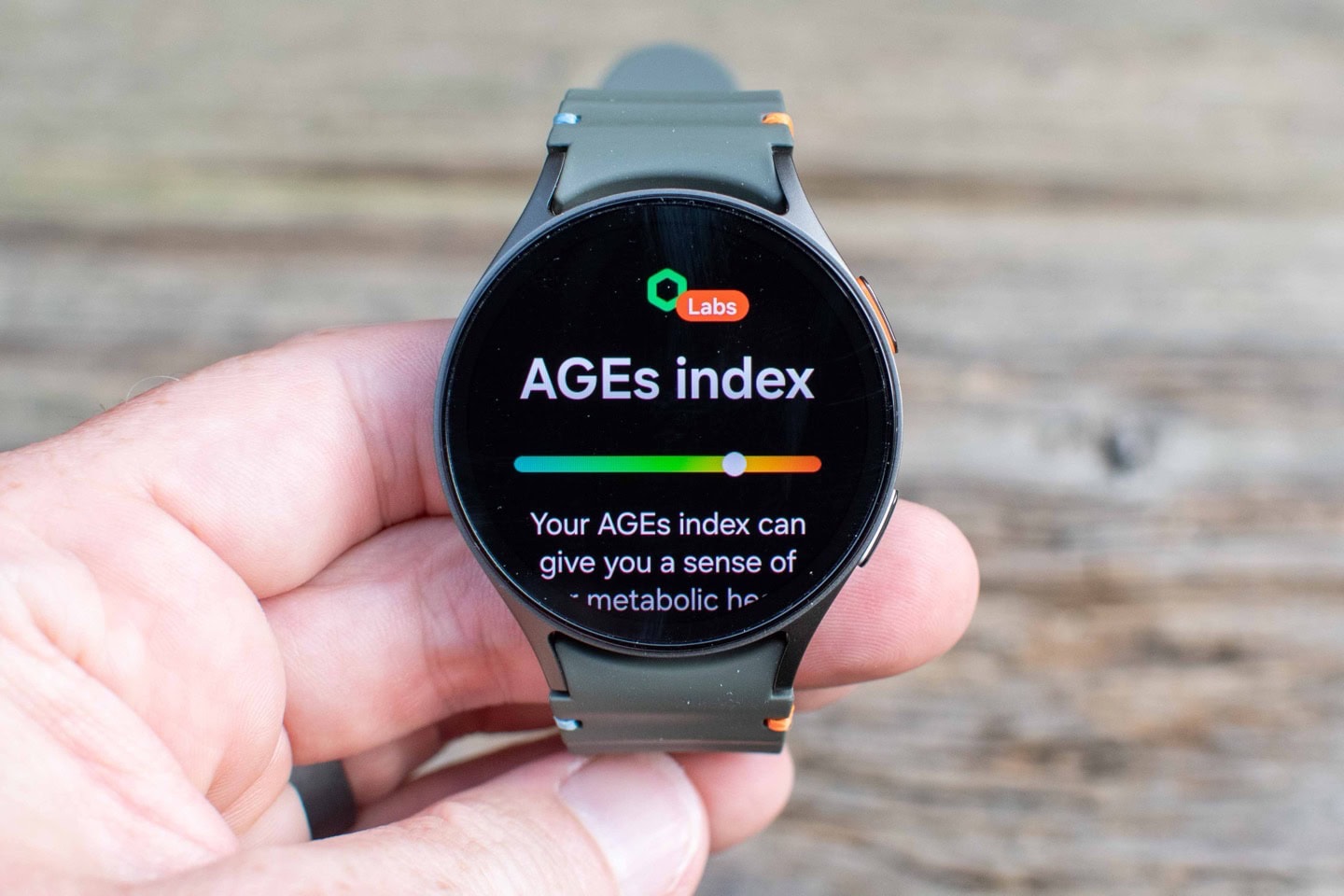
First up, we’ve got the main either new or big-spec items on the hardware front:
– Priced at $299 for 40mm, $329 for 44mm (and +$50 more for LTE editions)
– Available in two sizes: 40mm and 44mm
– Available in both BT/Wifi and LTE editions
– Waterproof spec is 5ATM/50m
– Added dual-frequency/multiband GNSS
– Increased display to 2,000 nits
– Sapphire glass display, aluminum case
– Increased storage from 16GB to 32GB
– New 3nm processor, Samsung says is 3x faster
– New optical heart rate sensor, Samsung says is more accurate
– Battery claims are 30-hours smartwatch mode, with an always-on display enabled
However, it’s the software that’s just as interesting here. Here’s what else is new on the software front:
– Will use Google WearOS 5 (first watch to do so)
– Adding cycling FTP prediction via App: Claims to be able to detect FTP in a simple 4-minute test, paired with Bluetooth power meter
– Adding triathlon/multisport workout mode (tracking all three sports in a full triathlon)
– Adding new running race partner mode to race against previous bests
– Adding support for Energy Score (see Galaxy Ring section)
– Adding FDA approved Sleep Apnea detection (first company to do so)
Note, that one big software difference between the Watch7 and Watch Ultra, is that the Watch7 does not support route following (e.g. course following). Beyond that, from a software standpoint both watches are virtually identical.
The Daily Basics:
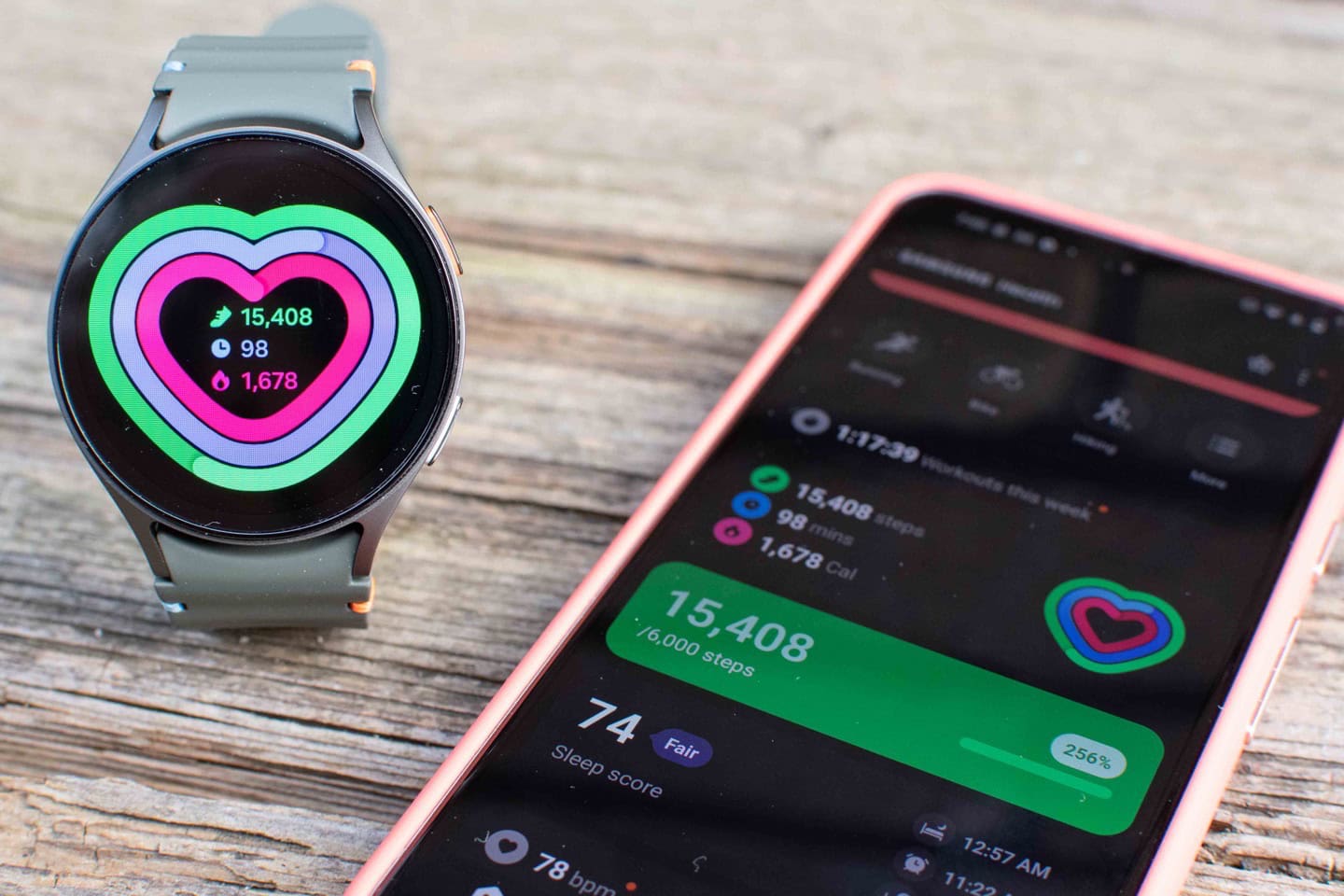
For this first section, we’re gonna walk through some of the day-to-day components. Everything from daily activity tracking, to the new Energy Score and AGEs pieces, plus stuff like smartwatch battery life, the display, buttons, and more. Then down below we’ll get into all the sports pieces.
First up is the display. The Galaxy Watch7 has a new 2,000-nit display, which is up from the previous 1,000-nit of the Galaxy Watch6. Frankly, the 1,000 nit display was perfectly fine (even in super bright sun), so this wasn’t really a big deal in the grand scheme of things. That said, just like with the Galaxy Watch Ultra review, I found it challenging to see the data underwater while openwater swimming (the only scenario where it was a challenge). I suspect Samsung’s automatic brightness algorithm here is keeping the display dimmer than it should be, so hopefully that’s an easier fix down the road.
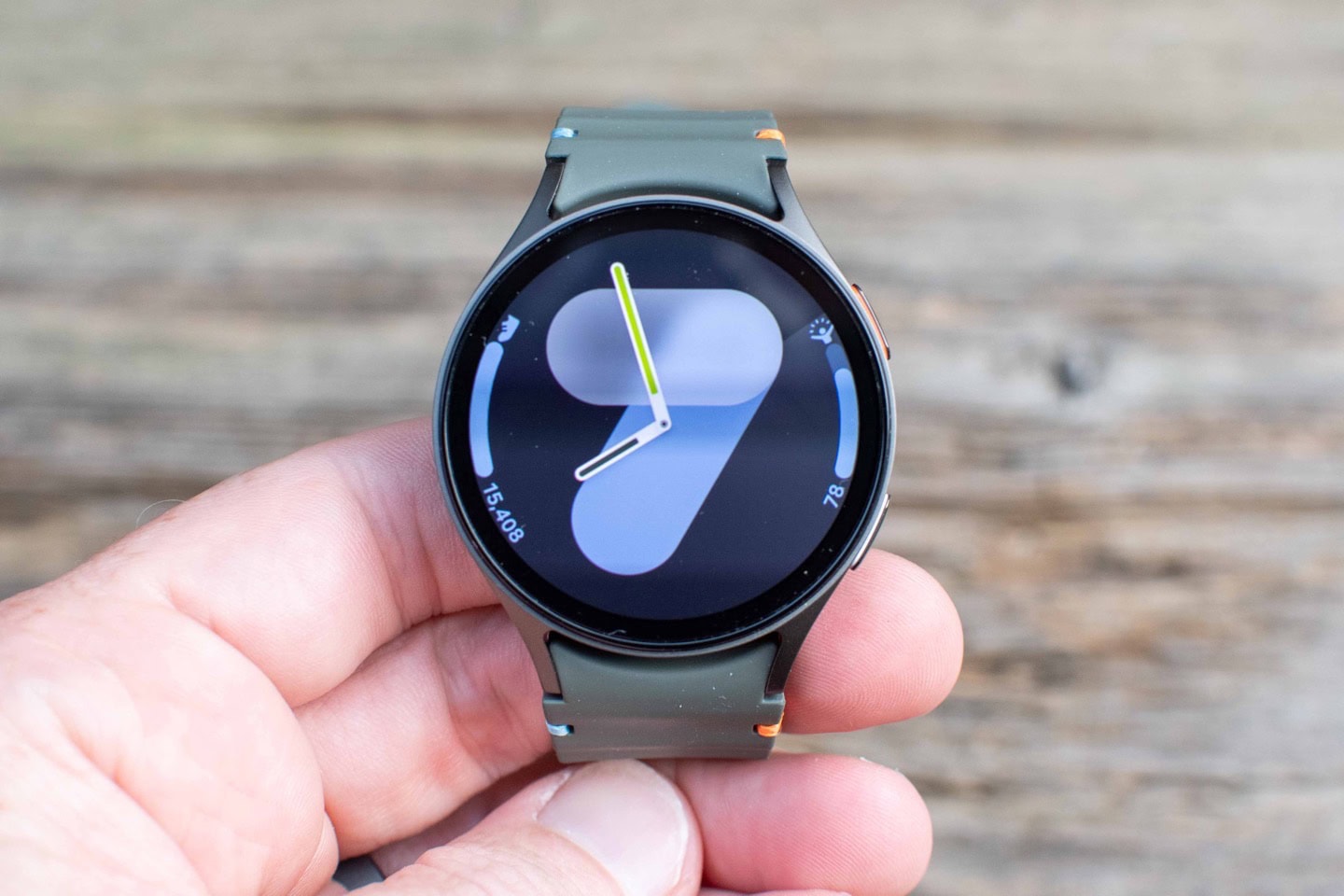
From a buttons standpoint, the unit maintains the existing two buttons of previous models. Additionally, it has a touchscreen. Unlike the ‘Classic’ models, it doesn’t have a rotating bezel, but can simulate that via a digital variant where you rub your finger around the outer edge of the screen. Note that the Ultra doesn’t have the physical rotating bezel either.
In terms of that touchscreen, it worked fine when dry, but none of Samsung’s screens are all that usable when wet in rain or heavy sweat. They seem a bit worse than their competitors in this realm, for whatever reason. As with the Ultra, it’s not a dealbreaker, just more of a fiddly thing to deal with if sweating heavily or in heavy rain.
In any event, the new Watch7 uses the also-new WearOS 5, the first company to leverage WearOS 5. Practically speaking, most won’t notice much of a difference in terms of day-to-day usage, aside from improved battery life (more on that in a second). For example, bits like swiping down from the top to access the controls menus are all essentially the same:

All of the WearOS pieces are also combined with Samsung’s One UI, which customizes the UI feel very slightly. Of course, the main benefit of WearOS is the ability to install various 3rd party apps. This can be fitness apps like Strava and Komoot, or music apps like Spotify.

Most of the time on the watch you’re going to be skipping to one of the various tiles. These can be customized, or just left as default. Tiles are essentially widgets dashboards, and you can get ones from Samsung/Google, as well as various 3rd party apps too. The first tile you’ll see of note is your health/fitness stats for the day, shown in the shape of a heart. This includes calories, steps, and active time. By tapping into it, you’ll get further details in a longer page:
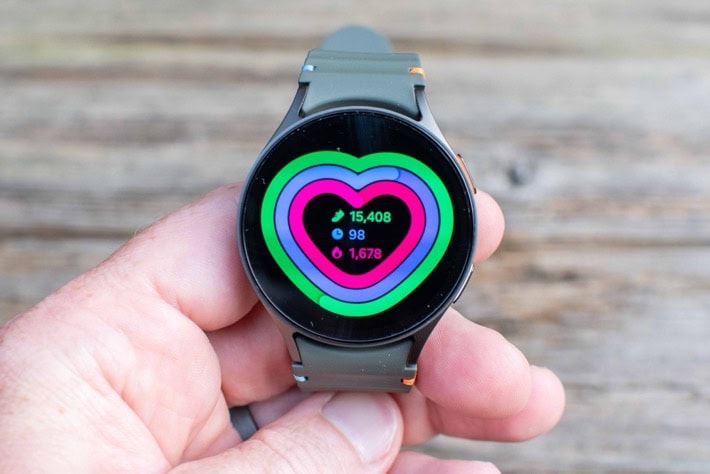
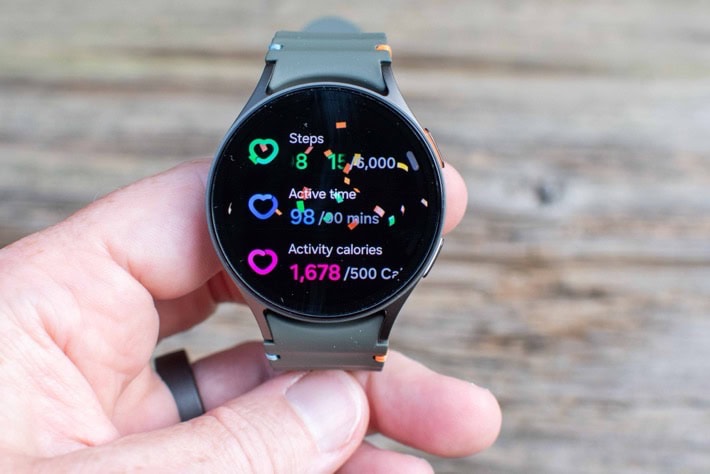
If you swipe again, you’ll see the new multisport page, followed by the more standard sports selection page. I’ll get back to the sports side in the sports section.
Instead, swipe again to see the new ‘Energy Score’ dashboard, which changes day to day based on a number of factors. This includes: Sleep time, Sleep Time consistency, Bed/Wake time consistency, Sleep Timing, Previous Day Activity, Sleeping HR, and Sleeping HRV. Additionally, it also seems to imply that both respiration rate and skin temperature are accounted for somehow, but doesn’t directly include that in the upper section of specs:
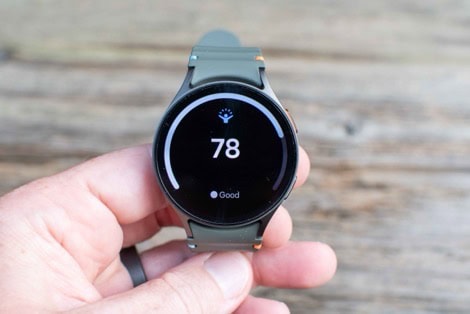
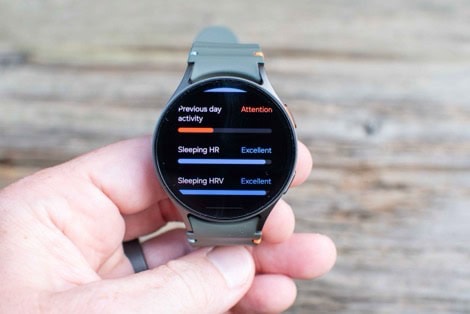
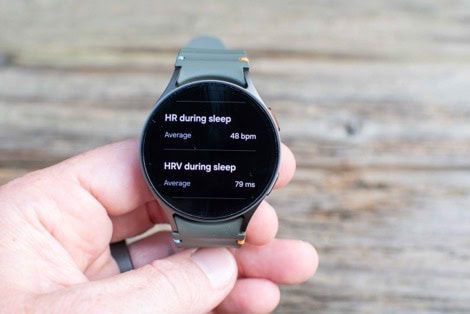
In using this over the last three weeks, there’s definitely some promise…but also some quirks. I think the number of factors it uses is good, covering numerous pieces, but it seems to produce incredibly stable scores most days, no matter the variations in my sleep/workout times. One day after a 9-hour ride, energy score did drop the next morning (appropriately). However, on other big workout days, it did not
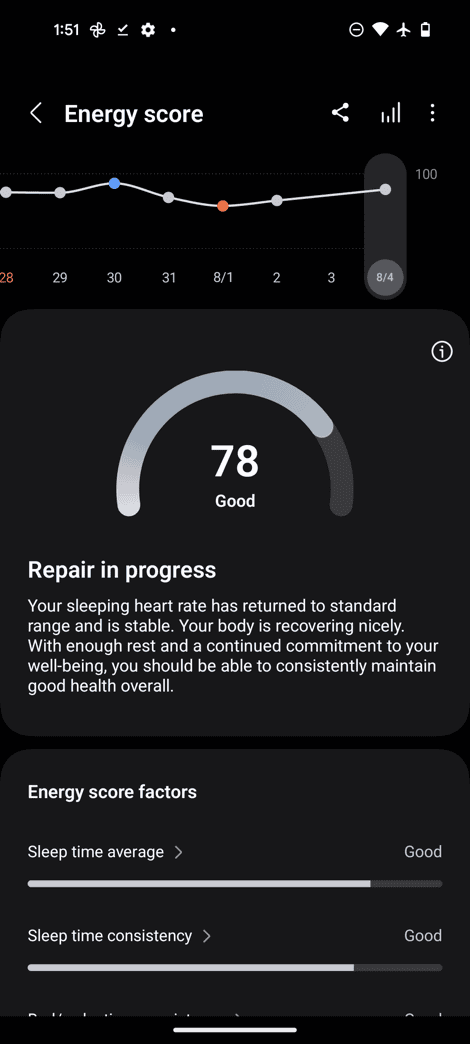
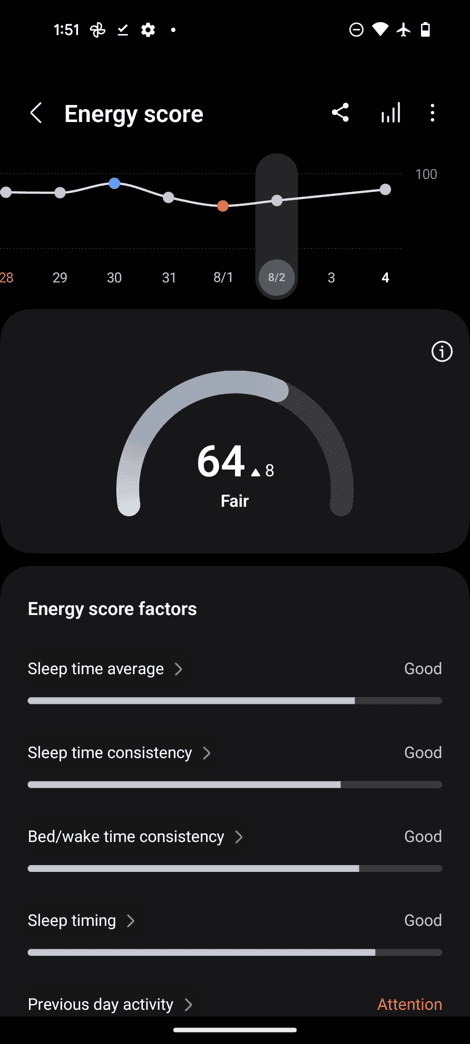
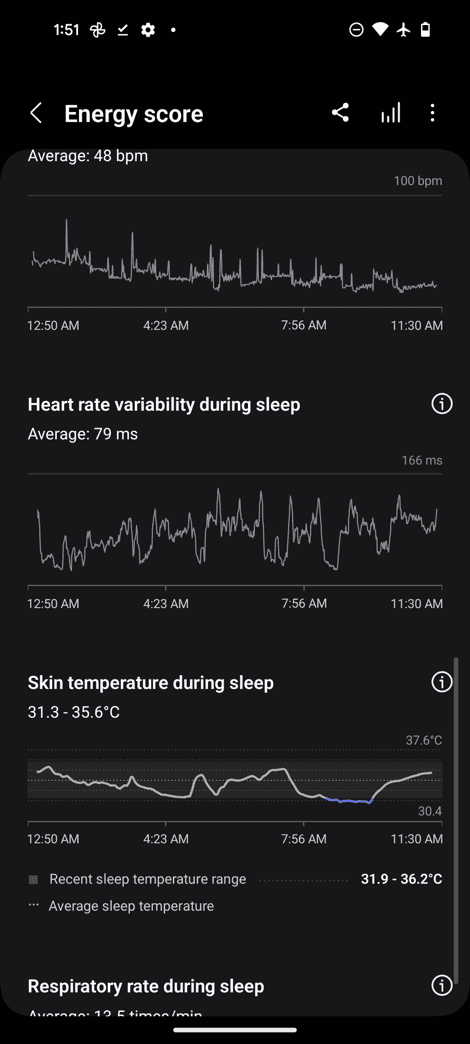
Further, even weirder, on the day after a transatlantic redeye flight, it didn’t dock my score because of low sleep (it said it was fine), but rather told me my “previous day activity” needed “attention”. Turns out, it docked my energy score because I didn’t do *enough* activity/steps that day. Wait, what?!? Energy score should have increased due to lack of activity, not decreased. Sigh.
In any case, moving away from energy score, the next dashboard section shows your current heart rate, current steps, current stress, and sleep stats from last night. You can tap on any of these to get more information, such as your stress or heart rate ones:
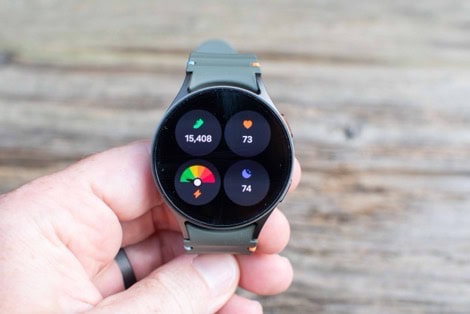
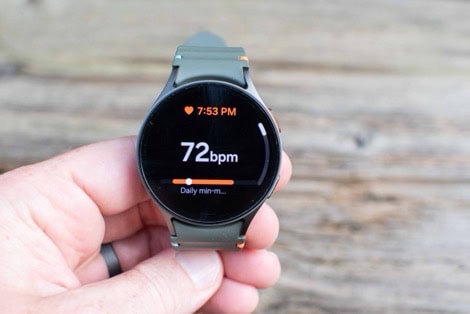
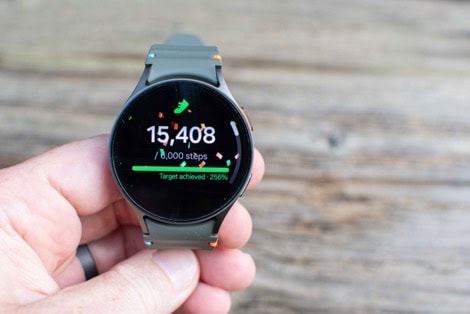
Here’s the sleep ones in more detail, on what happens the day *after* a transatlantic flight, when you just sleep very…very late (thankfully a Sunday).

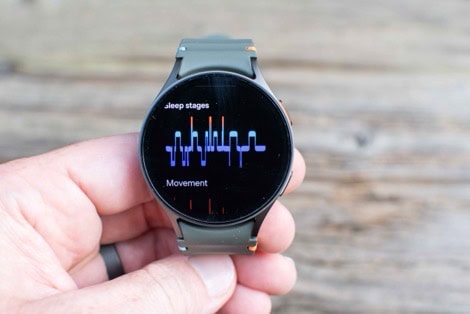

I’ve been tracking each night of sleep wearing the Watch7, and they’ve tracked quite well compared to numerous other devices I’ve worn at the same time, at least from a timing standpoint. Each night, just before dropping off, I would record the time I was falling asleep (I tend to fall asleep within a couple of minutes), and then each morning I’d log the time I woke up. And here, Samsung did quite well across the board in this realm, being very close in most cases:

In terms of sleep phases/stages, there isn’t really a great way to validate that. Even high-end comparison systems are only about 80% accurate on average in determining those sleep phases/stages, and within that, there’s broad variability. As I’ve said many times, I wouldn’t compare heart rate accuracy to something 80% accurate (or even 90% accurate), so doing it here isn’t something that makes much sense to me either. As a general rule, I see wide variety/variability between different units/companies for the same data sets.
That said, just as with the Samsung Galaxy Watch Ultra, the HRV metrics on the Samsung Watch7 seemed to be higher than the rest of the group (albeit, not as high as the Watch Ultra was).
Now, before we get to fitness tidbits, it’s important to note there are a few features that are only available if you have a Samsung phone. For this review, I used a Google Pixel phone, though I’ve also concurrently got another watch on a Samsung S21 phone, so I can cross-reference which features are/aren’t available. Here are the things that require a Samsung phone:
– ECG (Electrocardiogram): This allows you to make on-demand ECGs, which Samsung has had medically certified as a Software as a Medical Device program by the FDA (and equivalent in Europe). This is only available for Samsung phones, and only within certified countries.
– Irregular Heart Rate Rhythm Notifications: This feature runs in the background, and alerts you to irregular rhythms automatically. This too requires a Samsung phone, and also is only available in certified countries (they got FDA certification for this a few months ago).
– Blood Pressure detection: This feature automatically determines your blood pressure level, after calibration against another known device. My testing in the past found this finicky at best, as this is not a medically certified component (whereas ECG is). While there has been much talk of Samsung getting medical certification here, this hasn’t happened yet. Again, this also requires a Samsung phone.
However, despite Samsung saying certain other features like their new ‘Energy Score’ and ‘AGEs’ needing a Samsung phone, that’s simply not true. Here you can see these showing up just fine on both the watch, and my Pixel phone:
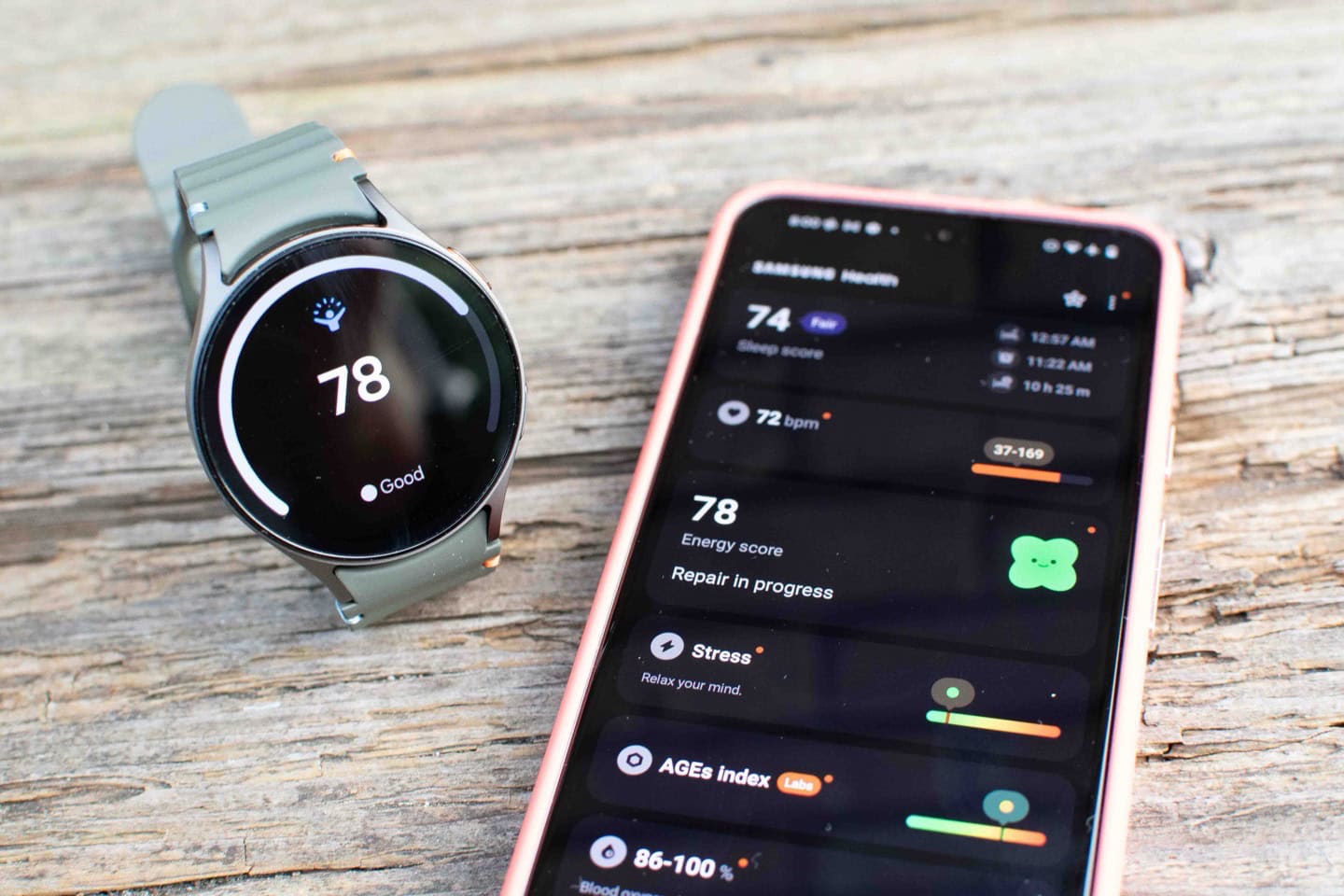
That said, setting aside the Energy Score, the new AGEs score is surprisingly useless. I can’t think of a more useless metric right now in sports technology. Largely because there’s literally no definition of it. Nor is there any clarity on which end of the spectrum is good or bad. Further, virtually every screenshot someone has shared on the internet, regardless of how fit that person is, appears to have the exact same value (roughly mid-yellow). Also, there are no actual numerical values, just…yellow.
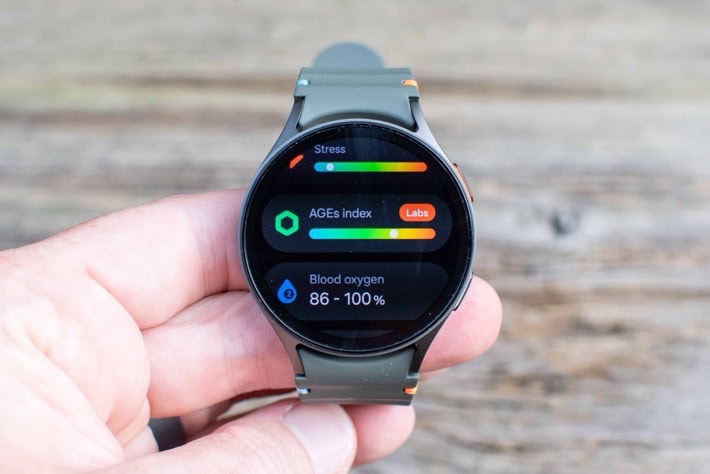
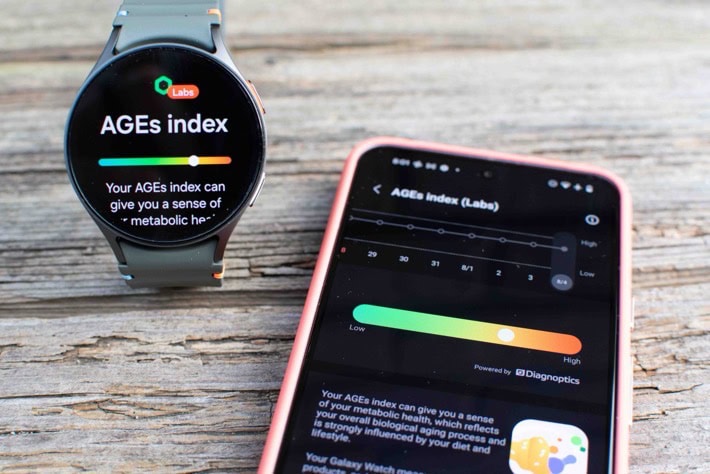
Supposedly it’s tracking “Advanced Glycation End-products”, and…that’s literally all Samsung says. They use a lot of words in their press release about it and the sensor, none of which provide any insight. C’mon Samsung, at least pretend to care here. If nothing else, tell us which end of the spectrum is good or bad.
In any case, beyond that, you can add more widgets to the watch, from either the built-in ones, or 3rd party apps. Built-in ones include things like weather, calendars, contacts, battery life, and so on.
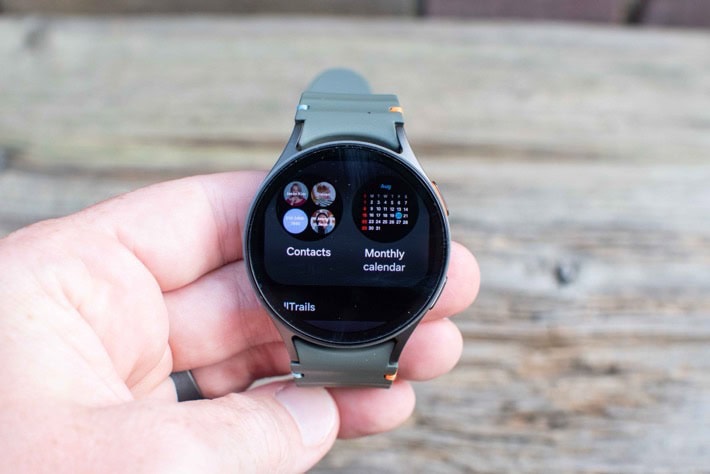
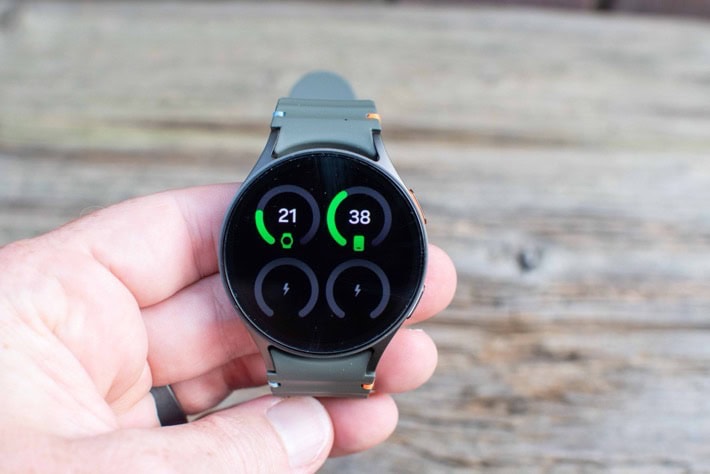
So about that battery life, how’s it been?
Surprisingly good. Mostly. Most days I’m getting a solid 1.5 days of battery life (non-LTE edition), which is on-target (or even better) for what Samsung is claiming at 30 hours (we’ll talk about sports in a second). That said, I have seen a few quirks where it seems like post-GPS activity (e.g. after a run), it almost appears to not shut off the GPS, and thus results in very high battery burn until attached to a charger. This is as current as yesterday, which is *after* the most recent firmware update from Samsung designed to address unusual battery burn issues some have reported. But again, as soon as I put it on a charger, it seems to resolve the high battery burn rate, killing whatever is causing the high battery burn.
In terms of things like smartphone notifications and everything else, that’s all basically the same as every other Samsung Galaxy watch from the last…forever. And more importantly, there’s a million other reviews out there that cover those sorts of things. So with that, let’s get into the sports goodness.
Sports Modes:
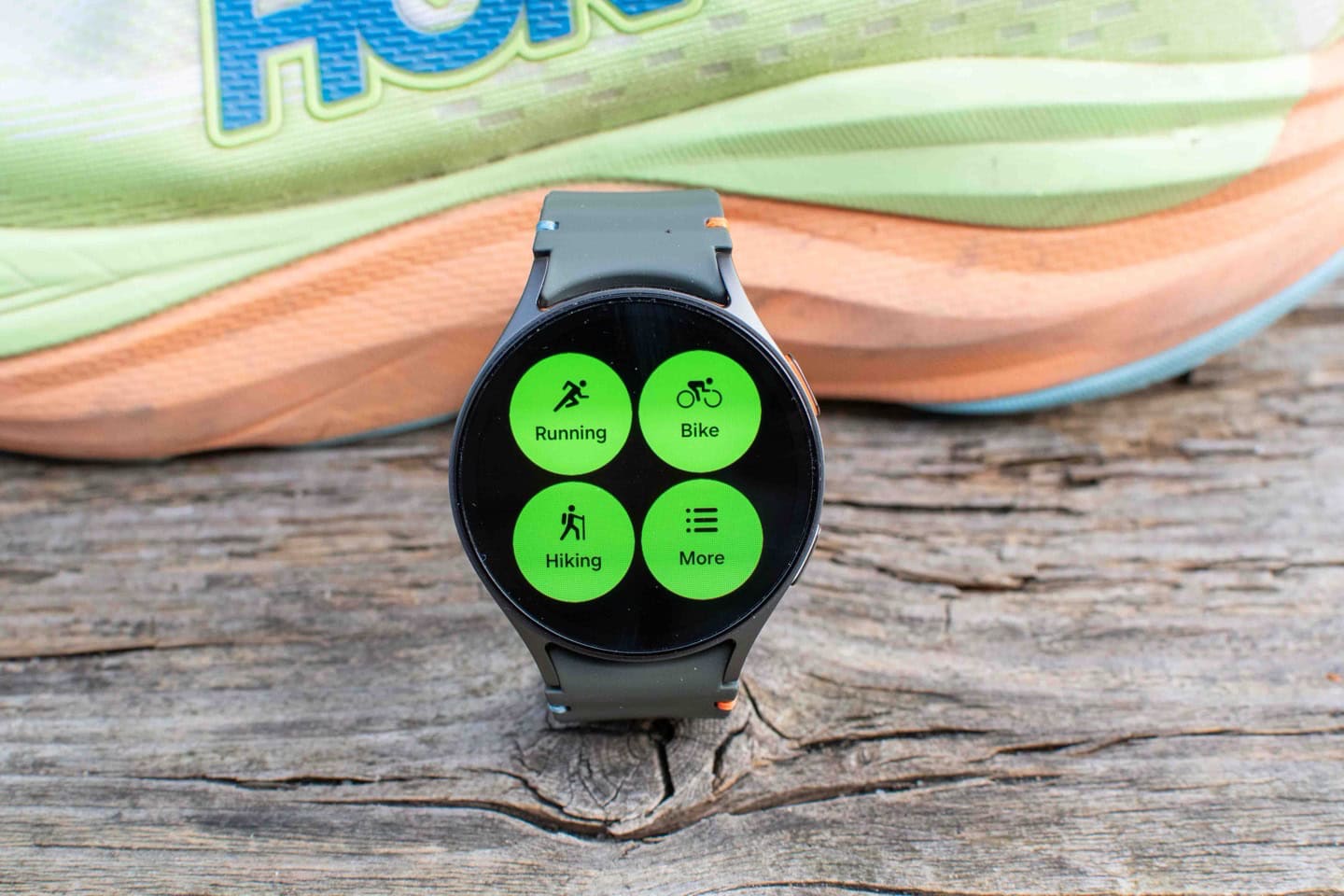
There’s more ways to start a workout on the Samsung Watch7 than there are hours in the day. You can swipe to the sports tile, you can swipe to the other (multisports) tile, you can open up Samsung Health, you could have a custom tile, and so on. However, for the most part, all roads eventually lead here:
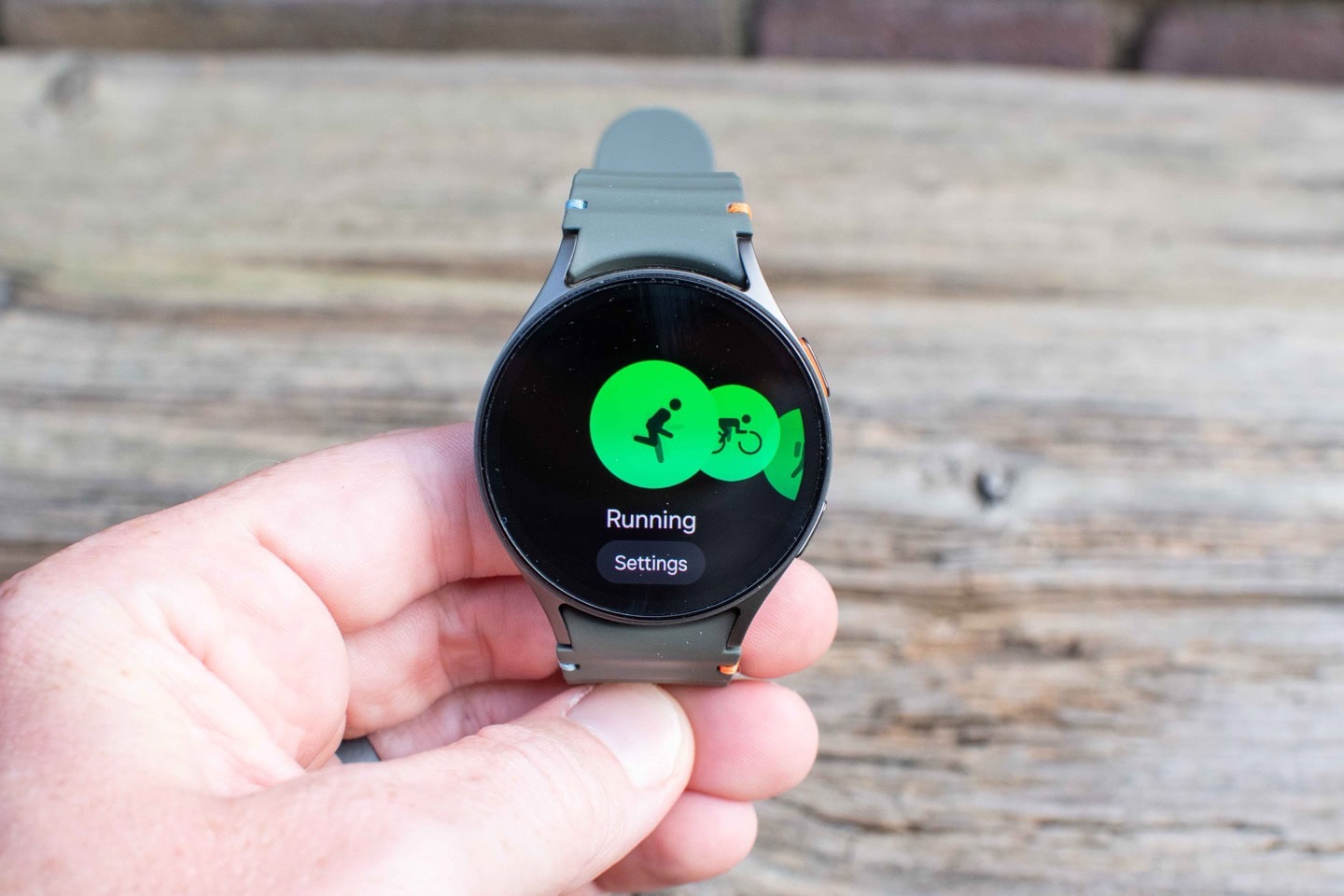
This is where you can swipe left/right through the different sport modes that are specified/customized on your phone in the Samsung Health app. At the top you’ll see the status of GPS lock (which usually only takes a few seconds, finally), and then at the bottom you’ve got settings. Note that Samsung added multiband/dual-frequency GNSS here, and it’s on by default for all activities (there isn’t a way to reduce it to save battery life). I’ll cover my GPS battery experience in a second.
At the bottom of the sports menu is the ‘Settings’ menu, where you can add various targets and tweak things for that particular sport mode.
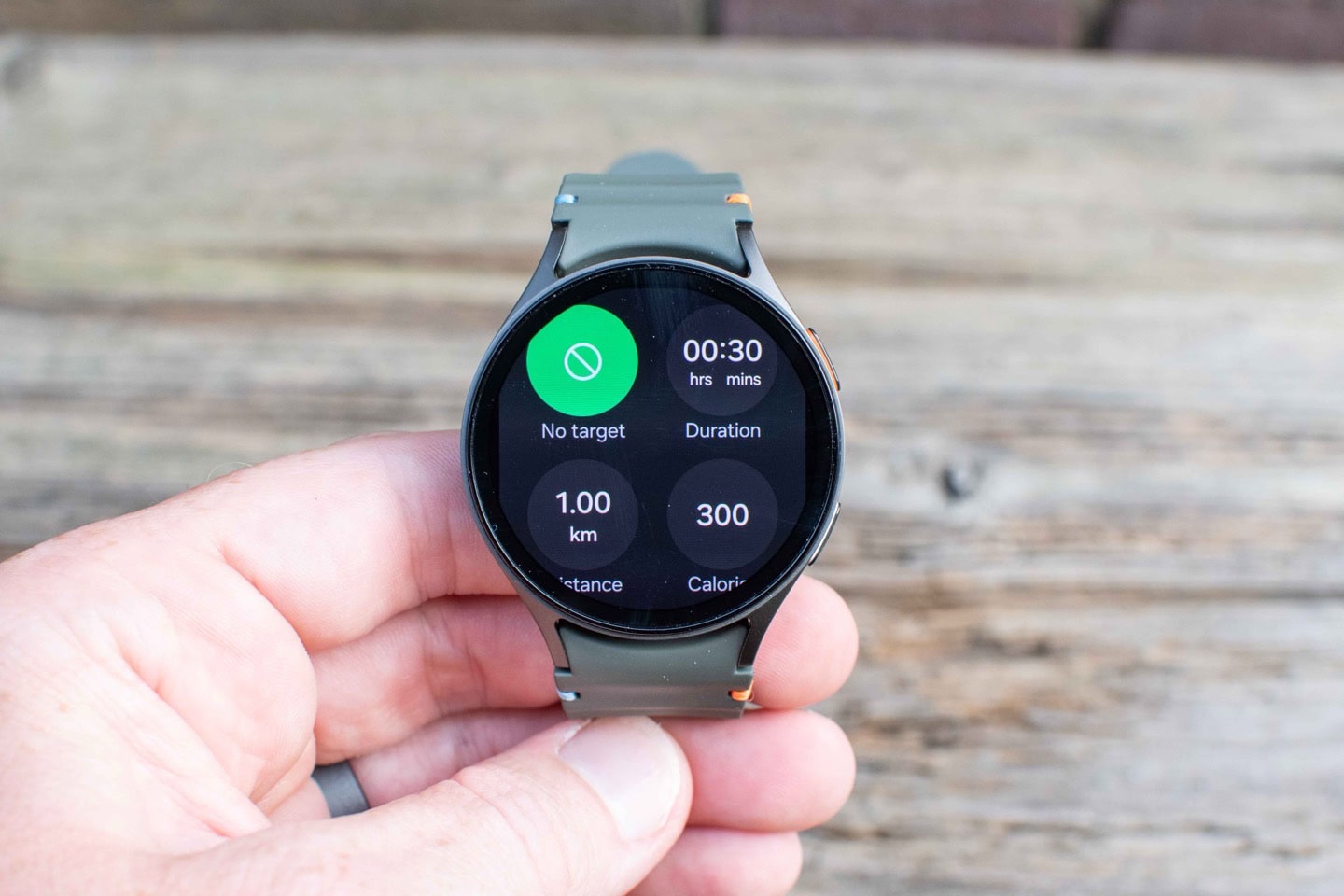
For example, in targets, you can specify a goal/target for the workout. This includes: Distance, calories, duration, or race. Further, you can configure custom intervals that you create on-watch. You cannot however select a route to follow (as you can on the Samsung Galaxy Watch Ultra, or Watch5 Pro).
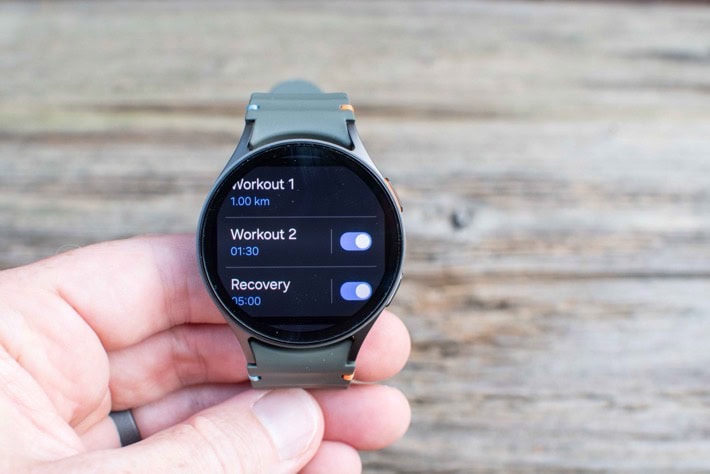
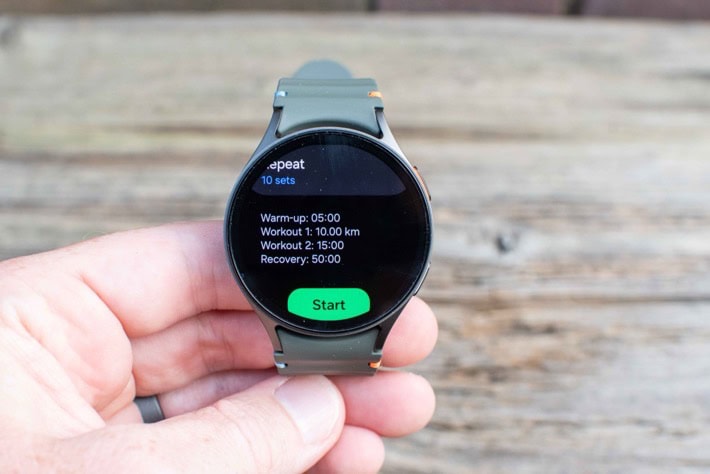
You can also customize the various data pages and data fields from the watch. You get two fully custom data pages, plus a HR zone page and a running efficiency metrics page. There’s also an interval and map page, if those targets are enabled.
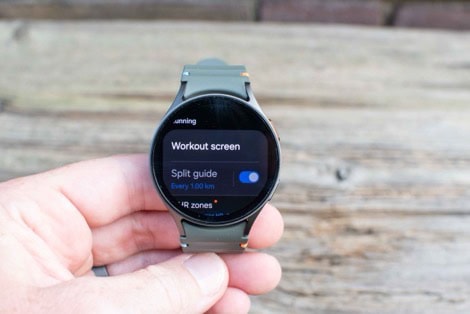
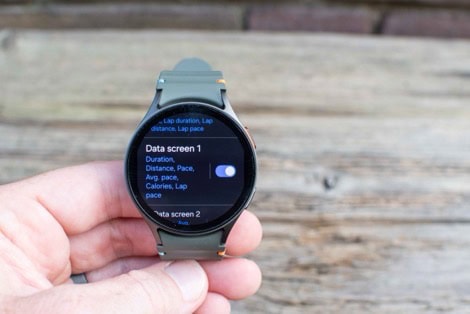
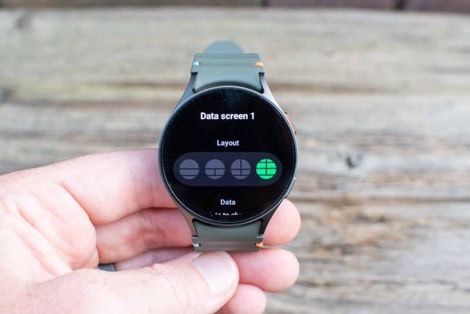
Just like with the Watch Ultra, for custom pages you can assign up to 7 metrics per page (at least on the 44mm variant, I don’t have a 40mm variant). I appreciate that Samsung hasn’t limited this further, just for fun.
Samsung has most of the core data fields you’d want, though not quite near as many as their endurance-sports-focused competitors from Garmin/COROS/Suunto/Polar/Wahoo. Apple also has more, as well as more data page configuration options/graphs. Samsung does not have any running power, as the rest of those companies do.
– Duration
– Time
– Calories
– Heart Rate
– Average Heart Rate
– Max Heart Rate
– Distance
– Average Pace
– Average Speed
– Pace
– Speed
– Steps
– Cadence
– Percent VO2 Max
– Elevation
– Elevation Gain
– Lap Pace
– Lap Distance
– Lap Duration
– Lap Speed
– Lap Calories
– Set
This above list hasn’t changed this year at all, nor is there any difference to the Watch Ultra, it’s identical. Likewise, the ability to customize zones that was introduced last year remains. This includes setting custom HR zones in a few different manners:
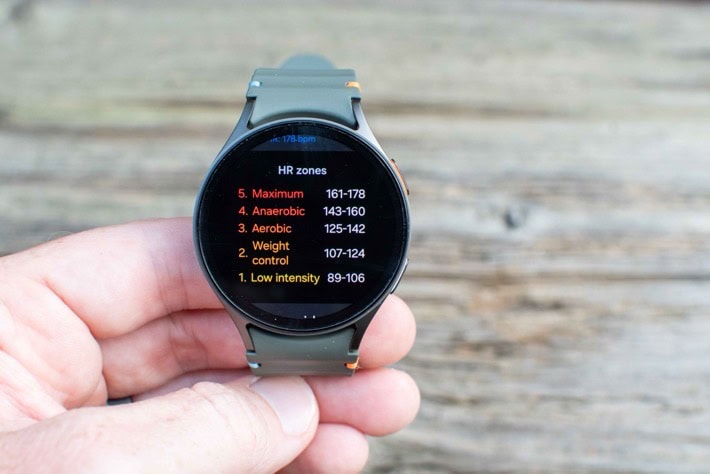
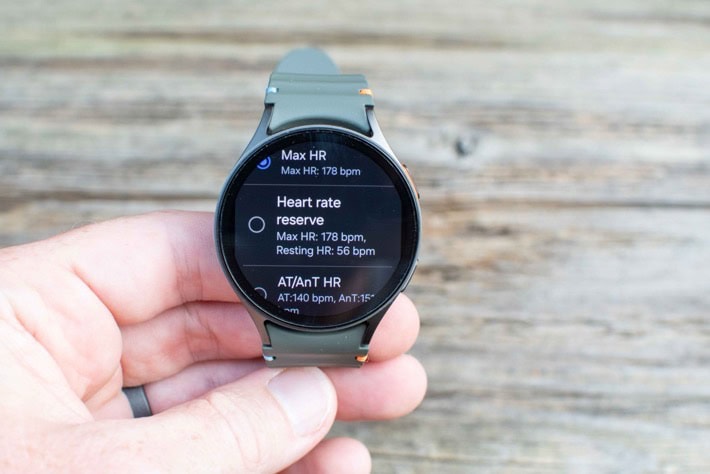
Now, it’s important to note that while Samsung talked about connecting a cycling power meter, that’s *NOT* done at the watch level. In fact, the Samsung apps on the watch are unable to connect to any external sensors (HR, cycling, or otherwise). While third-party apps can still write their own connectivity bits to sensors, there’s nothing native on WearOS or the Samsung apps to do so.
Instead, if you want to connect a power meter, you need to use the Samsung Health app on your phone to scan for the power meter (which does require internet connectivity, oddly). It’ll oddly also ask for a crank length on every power meter, even those that have no business needing a crank length (like a smart trainer or crankset-based unit, as only power meter pedals need that data). Once that’s done, the app itself will solely maintain a connection to the power meter during your workout (and there’s no way to see the power data on your wrist). You need to see ‘POW’ in the upper left corner of the app.
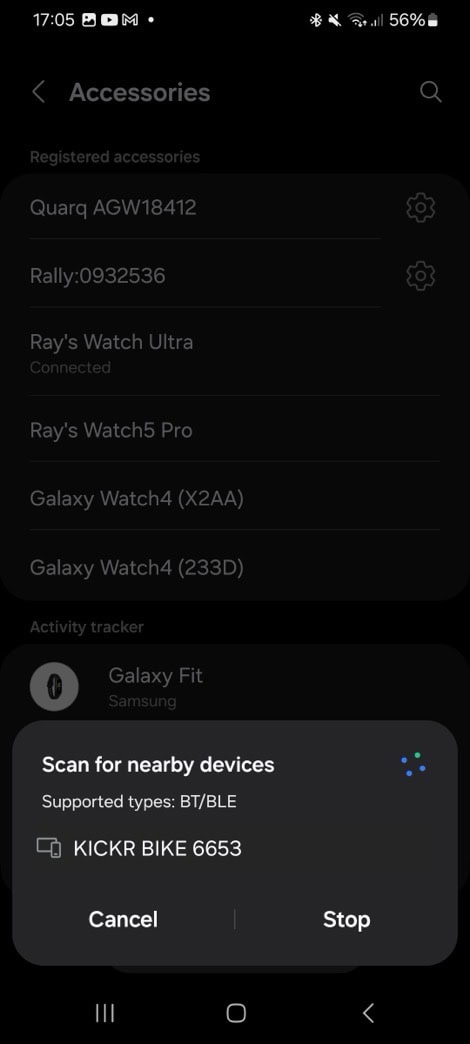
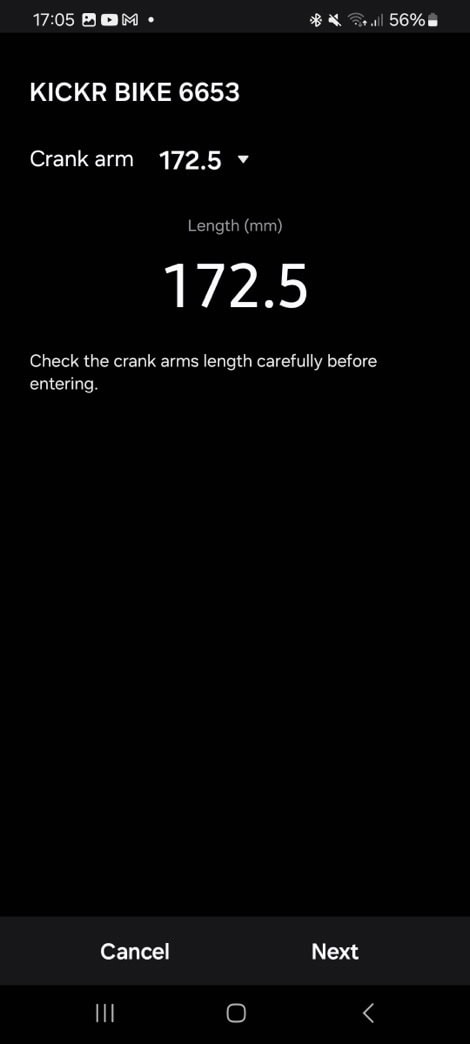
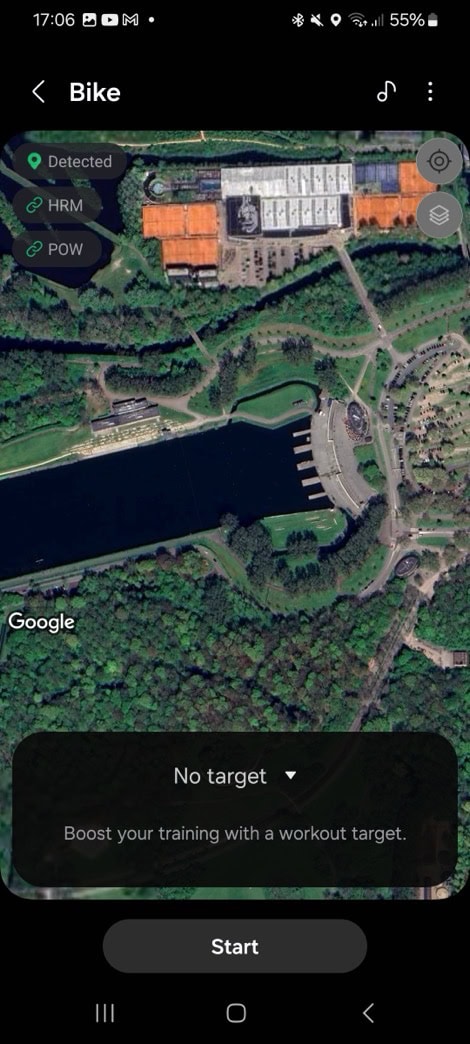
In trying this many times, I can say without question, that the entire power meter piece is a proper dumpster fire. It rarely remembers my power meter pairings, and when it does, it promptly disconnects for unknown reasons (without notifying you) a few minutes into the ride. I’ve tried four different well-known and trusted power meters, all exhibited the same issues. This is very much just a Samsung issue.
Likewise, I’ve published an entire video on Samsung’s much-vaunted “FTP prediction in 4 minutes” new feature they rolled out here. That too, isn’t awesome. You can read about it here, or watch the below video:

Thus, skipping beyond that, we’ll just do a normal workout. Here, once we start the workout, it’ll show and record data in terms of how you configured it (obviously). It does a 3-second count-down, and then begins that recording process. You can swipe between the data pages, and enable a water-lock (which I recommend if you have long sleeves, a coat, or gloves on, as I found it’ll otherwise stop/end the activity randomly). Here’s some mid-run shots:
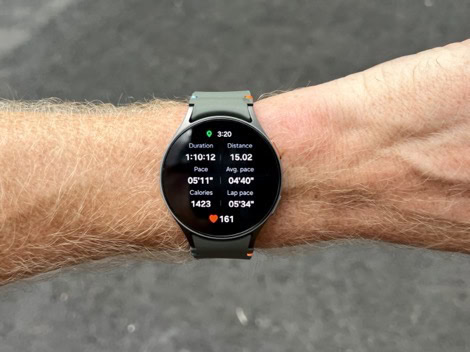
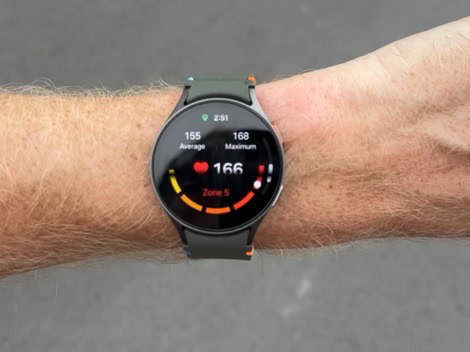
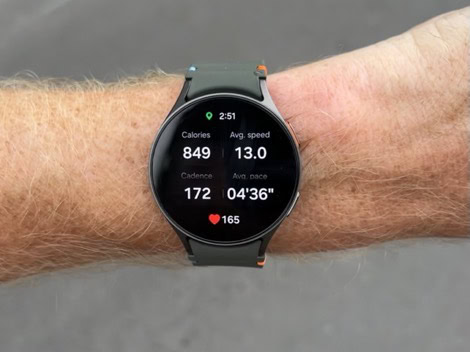
You’ll get splits as well, per your configured settings:
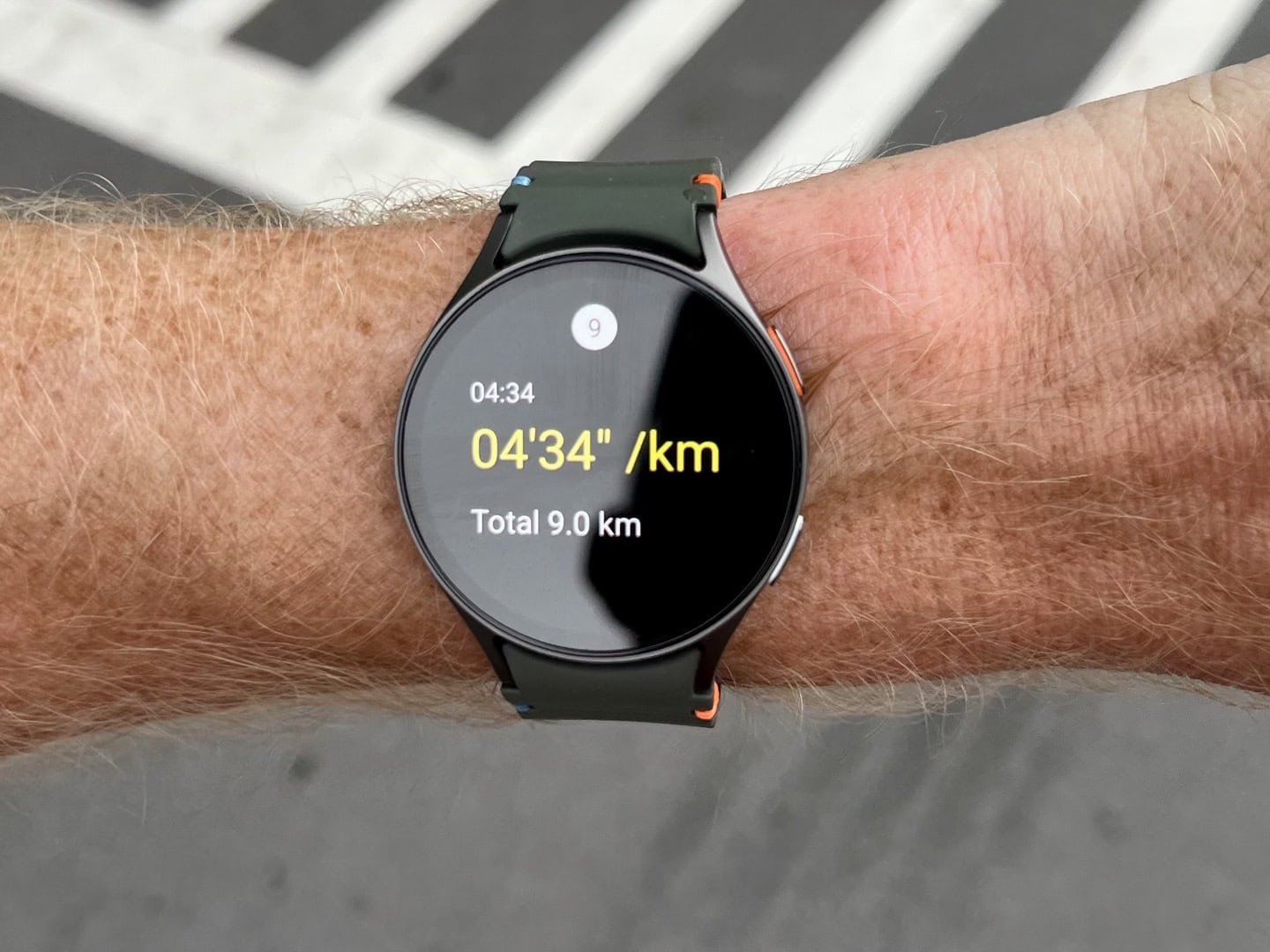
All of this worked just fine during a run. I got automatic laps per my settings (1KM on running, 5KM on cycling), and ultimately, I didn’t have any issues with instant pace or such while running.
Following the completion of a workout, you’ll get a summary list of all your stats, as seen in the gallery below:
This same gallery is available on the Samsung Health app, where you can interact with it a little bit more. Further, your files are then synced to Strava (if configured as such in Samsung Health). However, beyond Strava, there’s very little 3rd party integration with other platforms. Samsung’s Health API is very closed, with only a few companies managing to get access to it. And Samsung’s own ability to export files is also very limited. I used FitnessSyncer as an app to get most of my data out of the Samsung platform, which does work well.
Finally, when it comes to battery life during a workout, let’s take a look at two examples. First, let’s look at that 8hr 40min ride into the mountains.
Start battery: 91%
End battery: 23%
Total battery used: 64% in 8hr 40mins cycling
Rough estimate battery potential: 8.6%/hour, or roughly 11hrs GPS time (no navigation as Watch7 doesn’t support navigation.)
That said, my battery burn times seem to be somewhat hit or miss. Usually hit like the above, burning roughly 8%/hour. But, occasionally miss, like this weekend when it burned almost 50% more battery than I’d have expected for this ~75 minute run:
Start battery: 52%
End battery: 38%
Total battery used: 14% in 1hr 16mins running
Rough estimate battery potential: 11%/hour, or roughly 8 hours GPS time
Nonetheless, it’s unclear to me why I can have these moderate swings in battery life burn.
Heart Rate & GPS Accuracy:
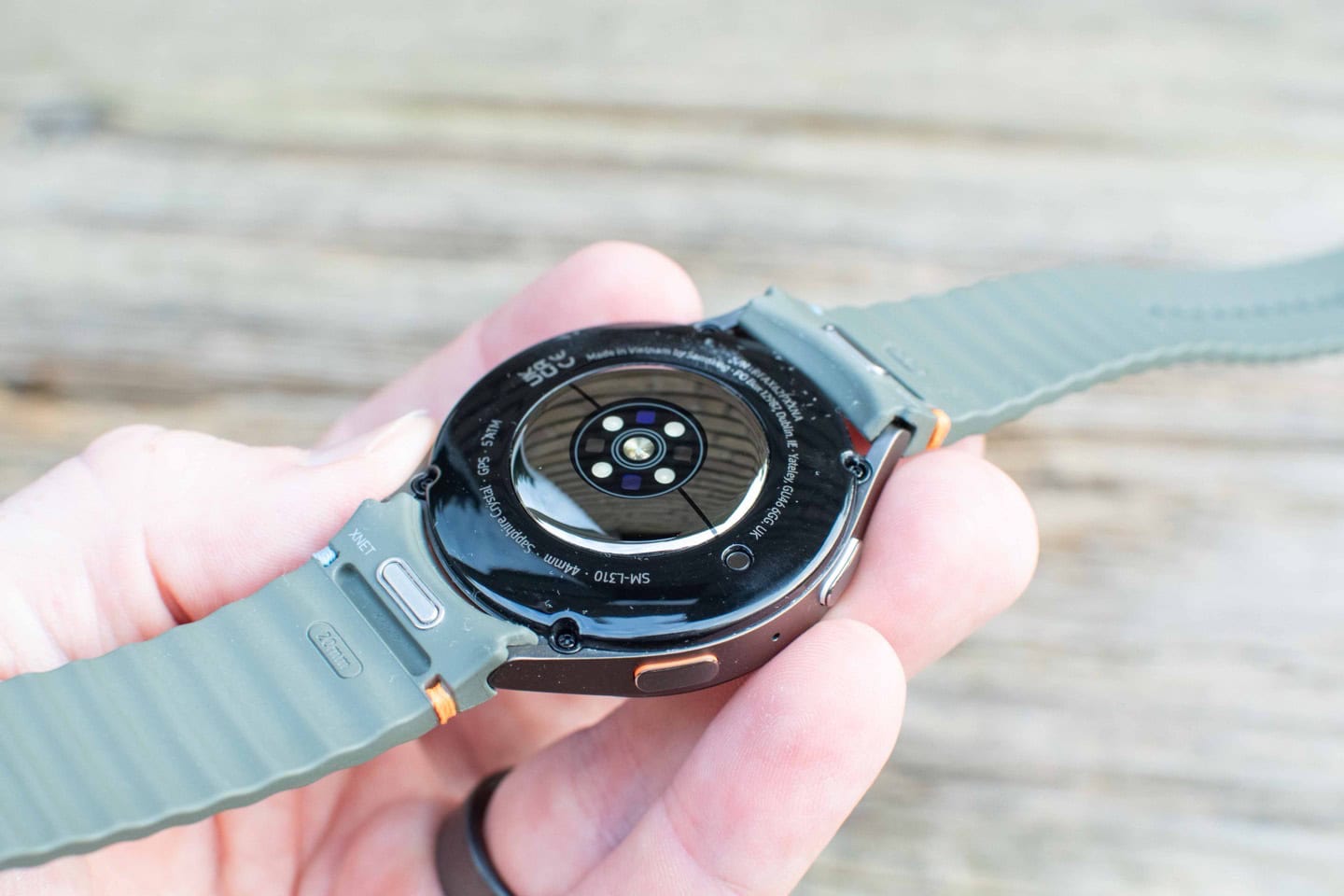
In Samsung’s keynote presentation announcing the Watch7 and Watch Ultra, they noted a significant change in both the heart rate sensor and GPS chipsets, focused on accuracy. In the case of heart rate, they revamped the optical HR sensor itself, aiming for higher accuracy. Whereas in the case of GPS, they switched to a multiband/dual-frequency GNSS system. This would (in theory) increase accuracy substantially.
If you look at my Galaxy Watch Ultra review, both of those things were true. The optical HR sensor was generally significantly more accurate than past Samsung efforts, and only really struggled with cycling. Meanwhile, the GPS tracks on the Ultra were far more accurate than any past Samsung watch.
Unfortunately, both of those are not true on the Watch7.
Having tested these side-by-side for nearly three weeks now on workouts across a variety of sports, in a variety of conditions and terrain – the results are very clear. And this includes the most recent firmware update over the past few days for the Watch7 (though, historically we’ve never actually seen follow-up firmware updates from Samsung make a difference in the accuracy department).
So, let’s get right into it, starting with heart rate accuracy. Here’s an initial run with the Samsung Watch7, as it compares to a chest strap, Samsung Galaxy Watch Ultra, and Whoop 4 band, and the COROS HR band (optical). Here’s the data set for these 800m intervals (you can open this link to see all the original files):
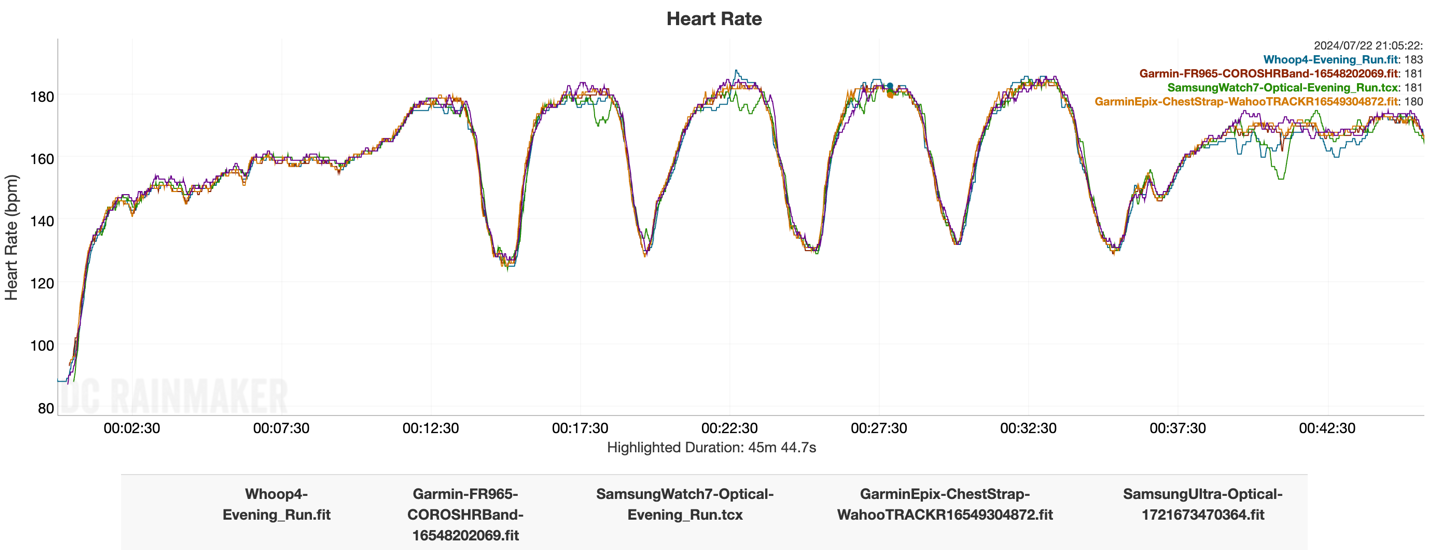
It struggles occasionally at the peaks of the intervals, but mostly holds the ship together. The Watch7 further struggles a little bit in half the intervals and the cooldown. We see some slight struggling of the Whoop 4 during the cooldown also, which is frankly quite odd since that’s kinda easy-town for it.
This was a run I had initially planned to be a 20-miler long run, but after 5KM, my legs were just flat in the midday heat, so I turned around and made it into some lazy intervals, bringing the total to 10KM. Here’s the data:
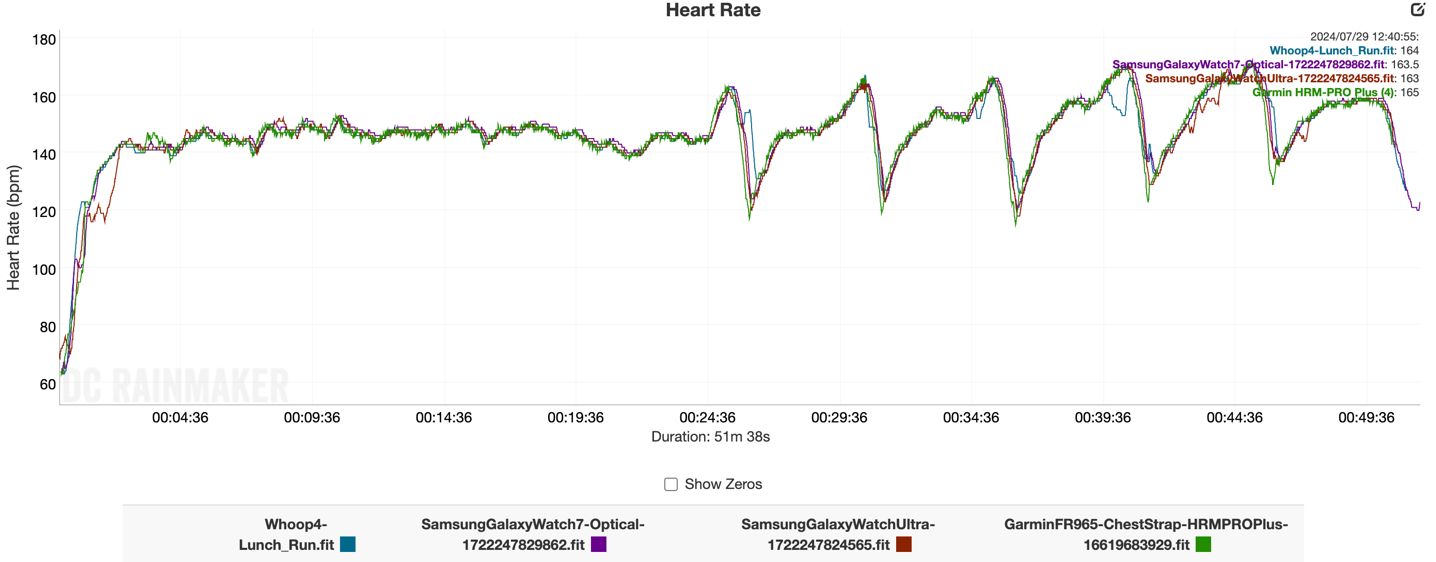
We see some initial minor quirkiness in the Galaxy Watch Ultra in the first 1-2 minutes, as well as during one of the last intervals, but overall, it’s pretty good. The Galaxy Watch 7 does well here too. Whoop has some minor issues on 1.5 intervals. Overall though, this isn’t a bad set.
Here’s another interval run over the past few days. You can see that on the whole it’s very close. Though, some very minor stumbles at the upper end of some intervals, but on the whole, pretty much the same as others.
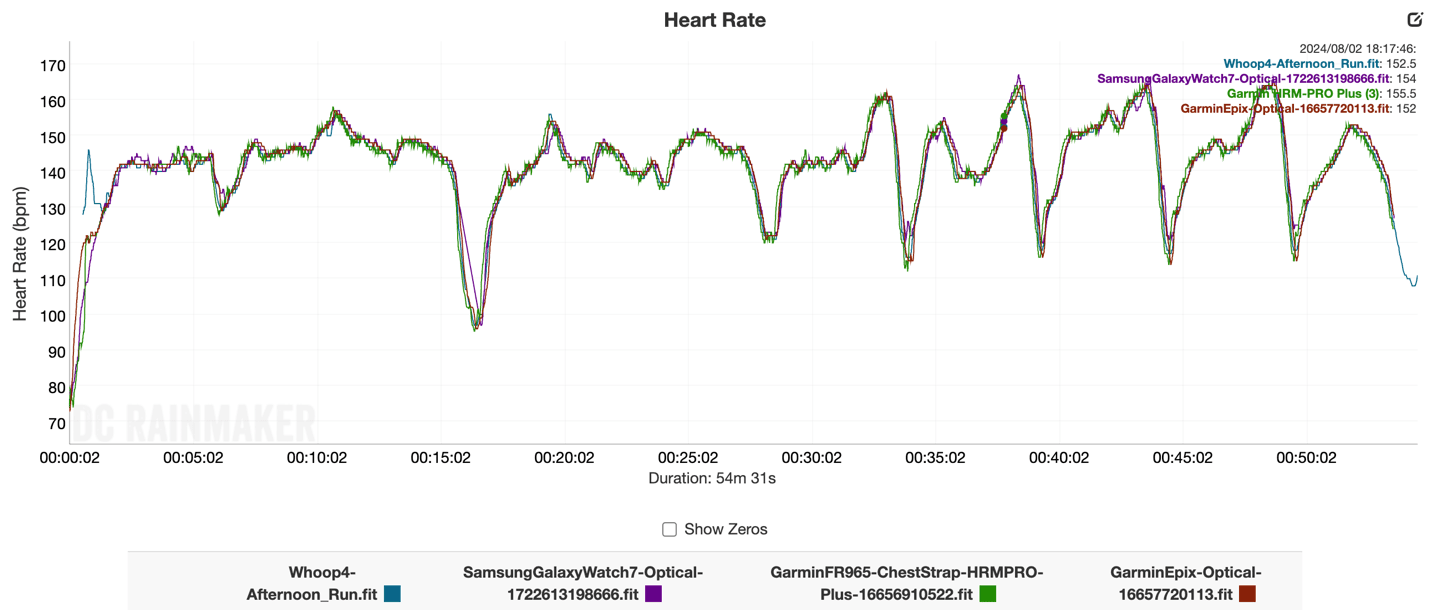
However, this run from yesterday shows a bit more variability, despite being a very steady-state run. You can see variations in the reddish color popping out above/below the trend line.
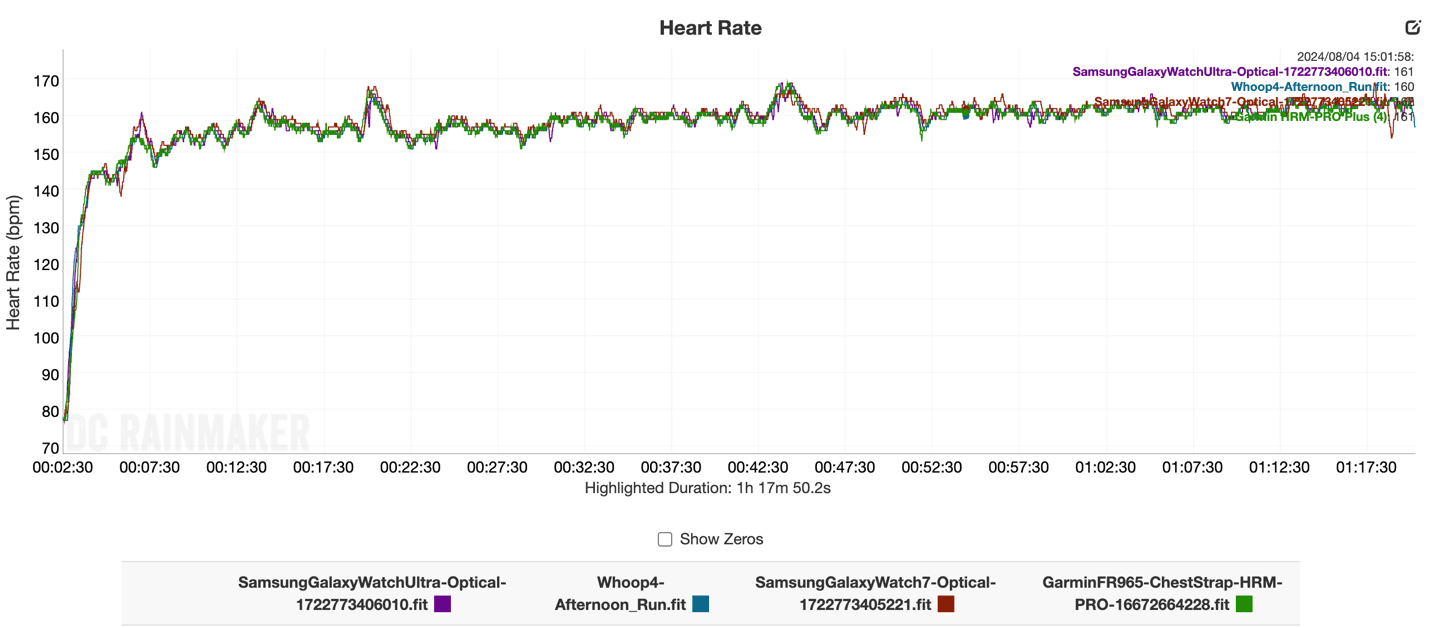
Now despite that, on the whole, things are much better than the Watch6 heart rate accuracy, and largely good enough for most running-focused scenarios.
However, in cycling, things tend to fall apart.
Next, looking at heart rate accuracy while cycling, I’m going to poke into sections of some longer 9-hour days. Looking at the entire day is just too messy (due to stoppage/etc…). But instead, I want to look at the nice long climb sections, to see how it handled. First though, here’s a 2.5-hour climb from the sea into the mountains.
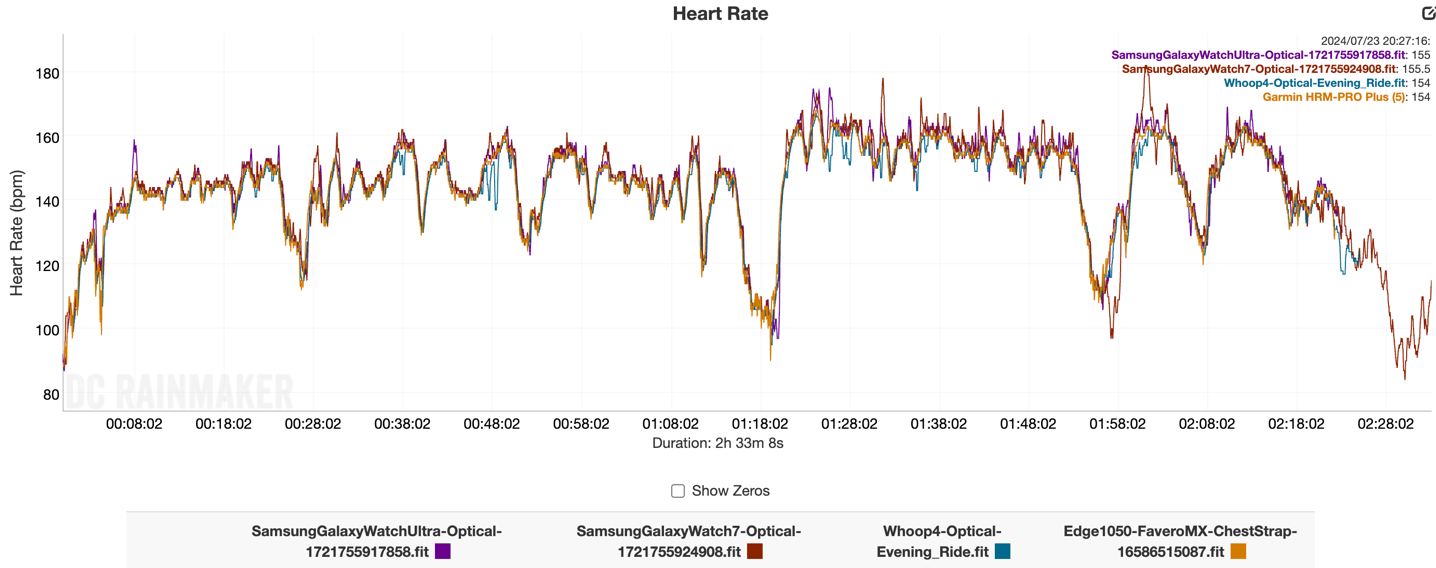
At first glance above, you’d think it was good. But as you dig into virtually any section on the ride, it’s actually quite variable, kinda all over the place, overshooting/undercutting. Essentially anytime I slightly surge the intensity, it overshoots or undercuts a bunch, as seen below:
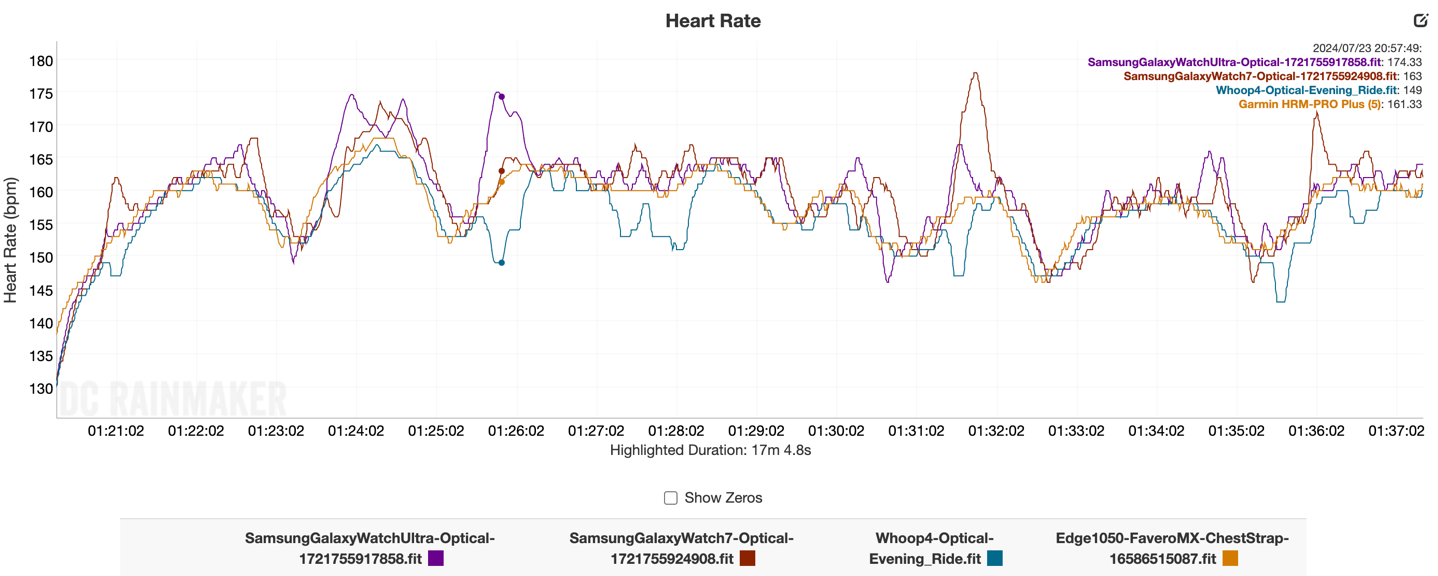
Obviously, Whoop isn’t great, but you can see the Watch7 actually seems to do a better job here following along the chest strap. You can zoom anywhere in that entire ride, and it’s basically the same pattern.
So, let’s move to the next day, going deeper into the mountains on a nearly 9-hour day of riding. As I said, given all the various stoppage time (due in part to eating, but also a very ugly flat tire situation), I’m just going to zoom in on the main climbs. Here’s one such climb:
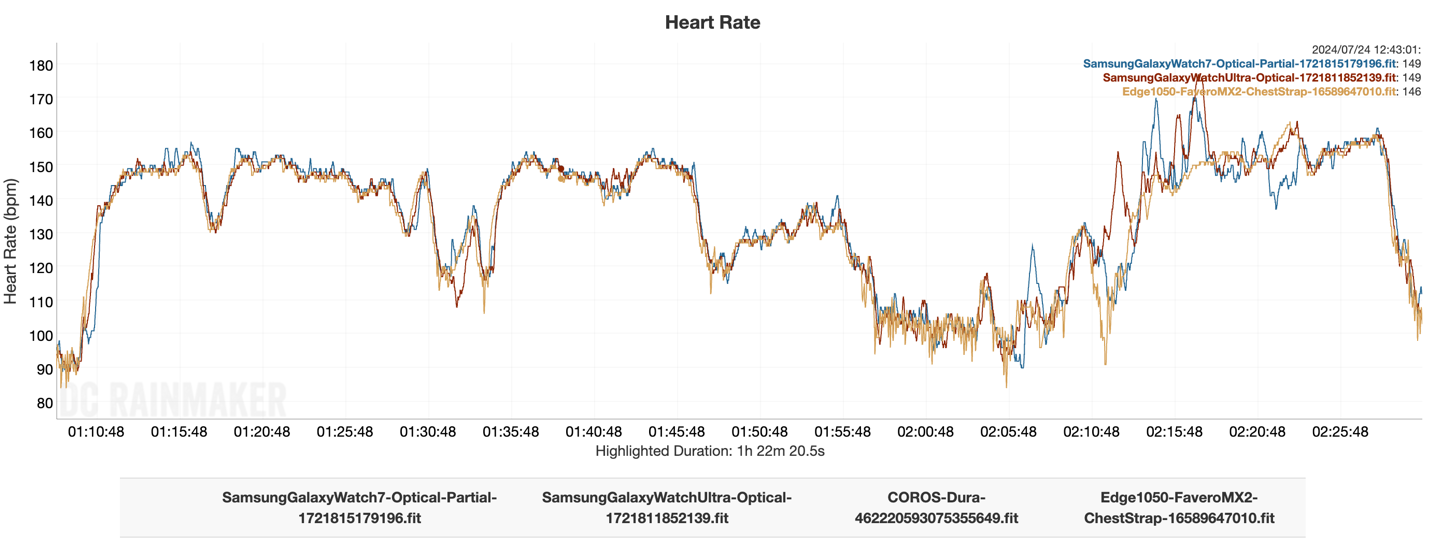
As you can see, at a high level, things are relatively close, but for whatever reason, on that last 3rd of the climb, things got pretty messy from both Samsung Watches, for no obvious reason. The chest strap remained nice and constant. I promise, I wasn’t doing 180bpm efforts in the middle of a 9hr day. That said, the bit where it started to shift from viably OK to pretty rough HR, was as the road did the same, going from a cleaner and more stable gravel, to a bit rougher. Perhaps that’s part of it, but then that doesn’t bode well for things like mountain biking.
And indeed, as the gravel route stays rougher, the heart rate from both Samsung watches remains largely unusable. Here’s another snippet later on, showing that quite clearly where the chest strap is nice and stable with my efforts as I try and maintain a steady pace, while the watches are all over the place (Ultra slightly better than Watch7 here):
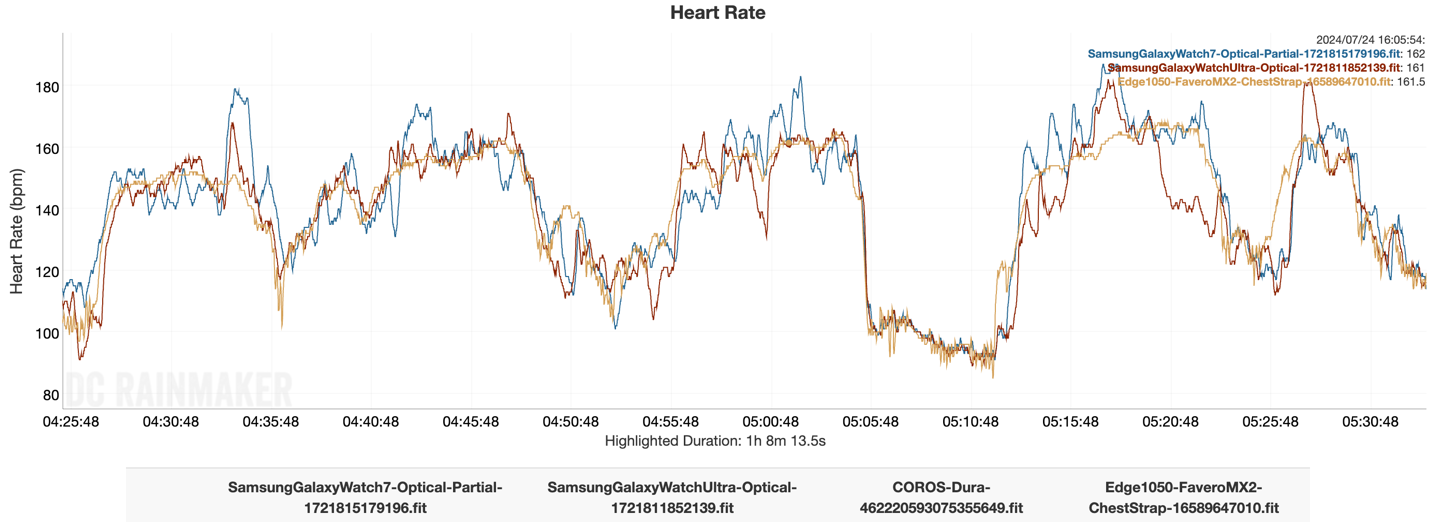
And again, you can look at the data sets yourself here, moving along the entire ride.
Ok, so setting cycling heart rate aside, let’s switch over to GPS/GNSS. Both new watches from Samsung gained multiband/dual-frequency GNSS. It’s extremely likely that both watches have the exact same chipset inside them. Looking at iFixit’s teardown at 1:55, you can see Samsung is running the Airoha AG3335M GPS chipset in the Watch Ultra, which is the same chipset used by most other endurance sports companies (e.g., Garmin, etc…). We haven’t seen a tear-down yet of the Samsung Galaxy Watch7, but it’d be extremely unlikely they’re using a different chipset, since that’s really the only one that’ll work from the Airoha library, without making other unlikely compromises.
However, what’s often unmentioned on GPS accuracy (especially in 2024), is antenna design. It’s just as important, if not far more important than the actual GPS chipset itself. A fraction of a millimeter the wrong way in antenna design results in a poor GPS track. And because every watch case is different (design, materials, etc…), that means every antenna design has to be uniquely tested.
So, with that in mind, let’s get right into it. In short, it’s not good. This should have been trivially easy for any GPS watch. It’s literally just a straight line. And indeed for the Samsung Galaxy Watch Ultra, it was – zero issues. That data set:
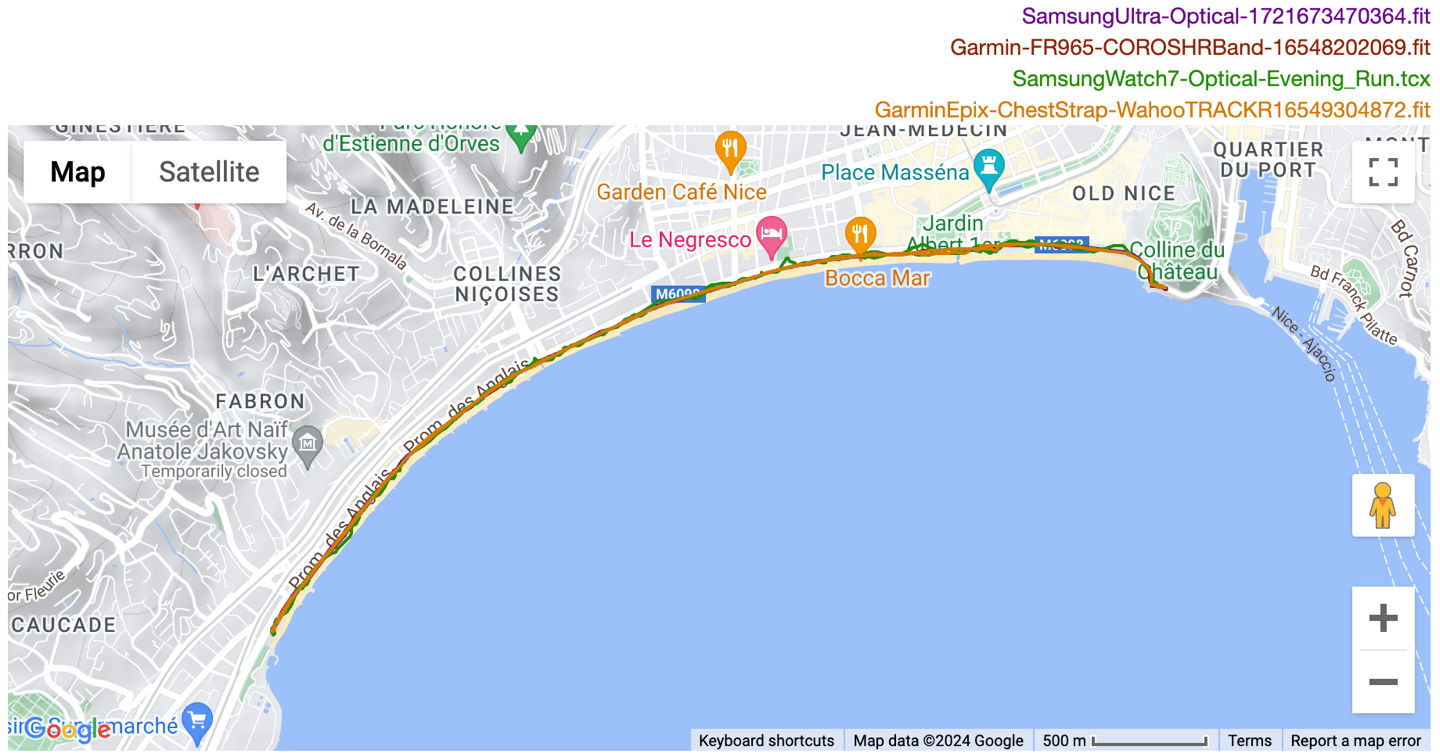
Yet, the Galaxy Watch7 drank far too much rosé beforehand, and plotted an impressively very bad GPS track.
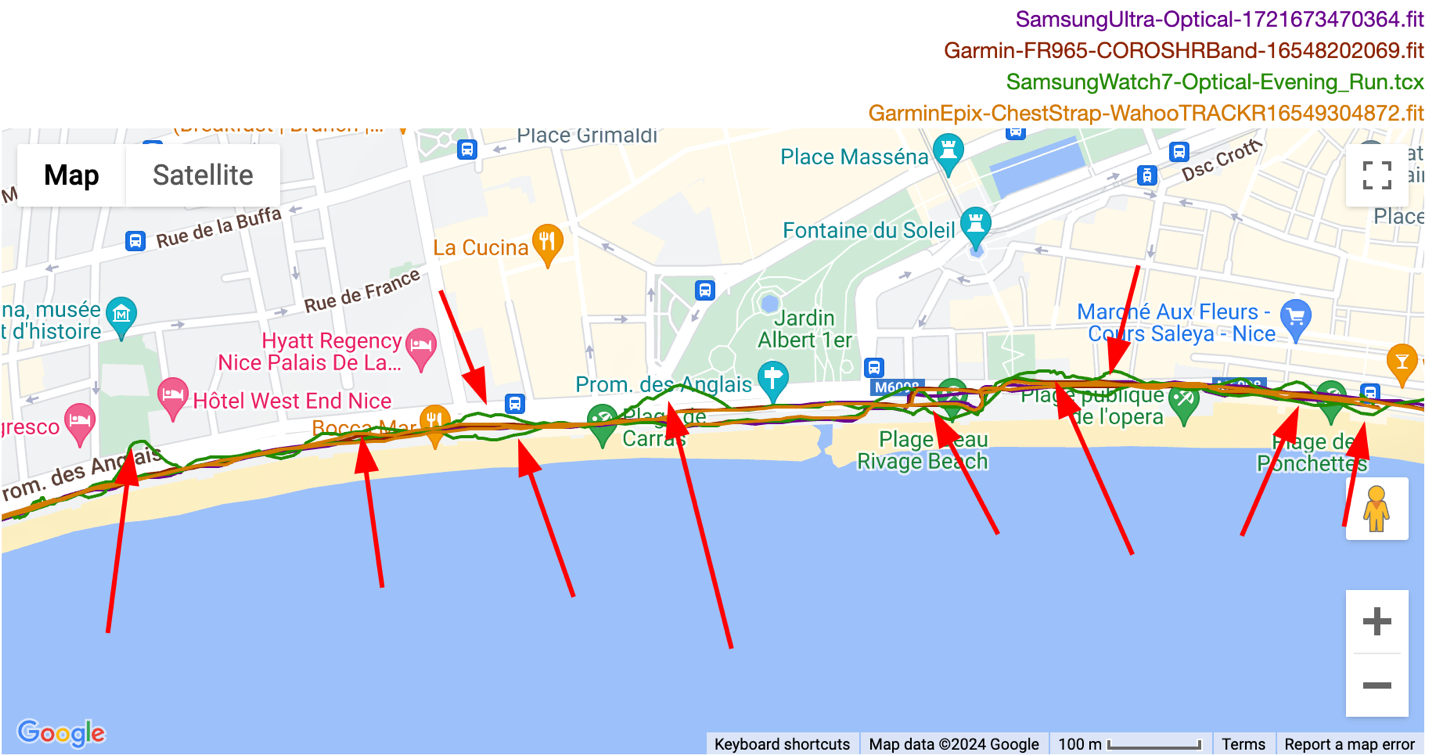
So, let’s increase difficulty slightly, this time in some forested areas, now a week or so later with the Watch7 as well. Here on this workout you can see the Ultra does perfectly fine, but as we zoom in, you’ll see the struggles of the Watch7. Here’s that data:

Look at all those purple spots where the Watch7 just meanders (quite significantly) off-path, and even into the water/canal.
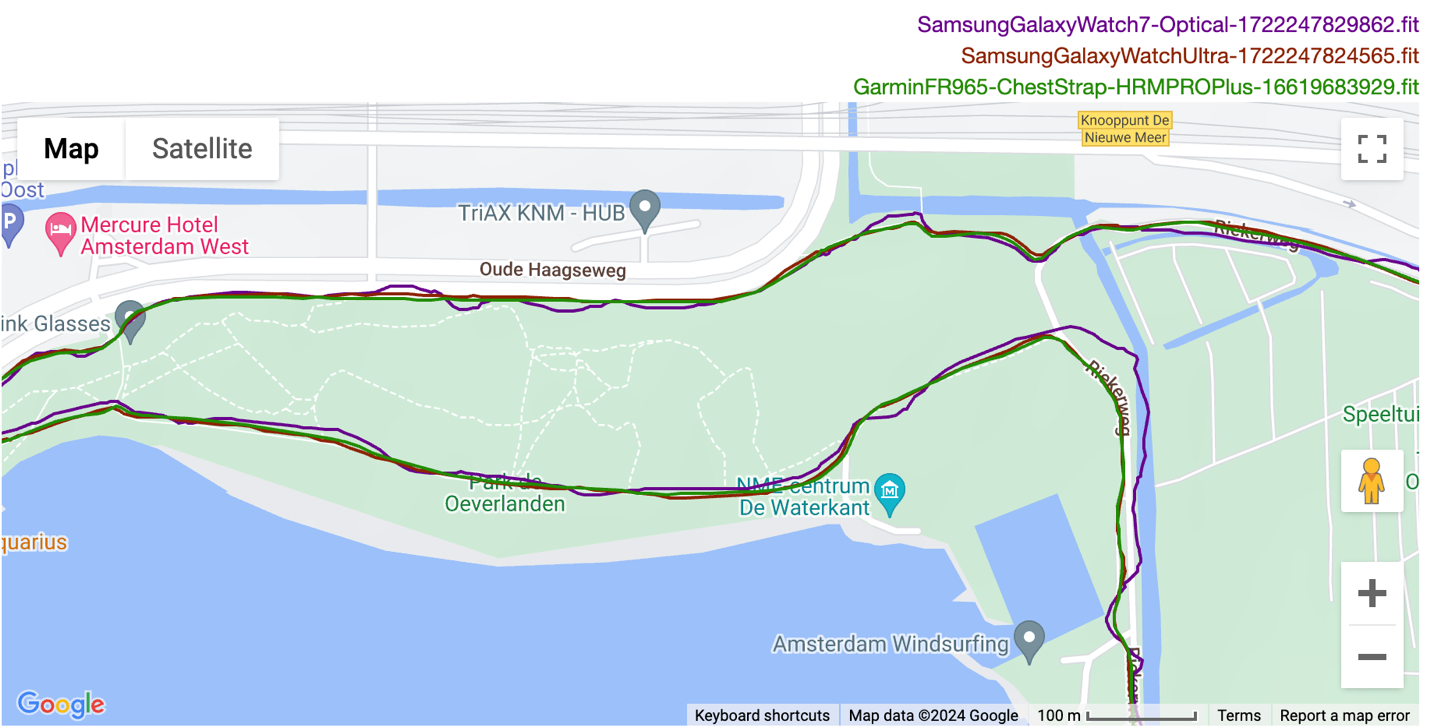
However, let’s just get even simpler. Here’s a run this past Friday in California, where I literally ran to the top of a giant pile of trash. The trash was buried, but they technically burn off the gas from it. There’s not a single tree around, or anything above me. It’s just grass. And yet, despite that, it still can’t keep a clean track:
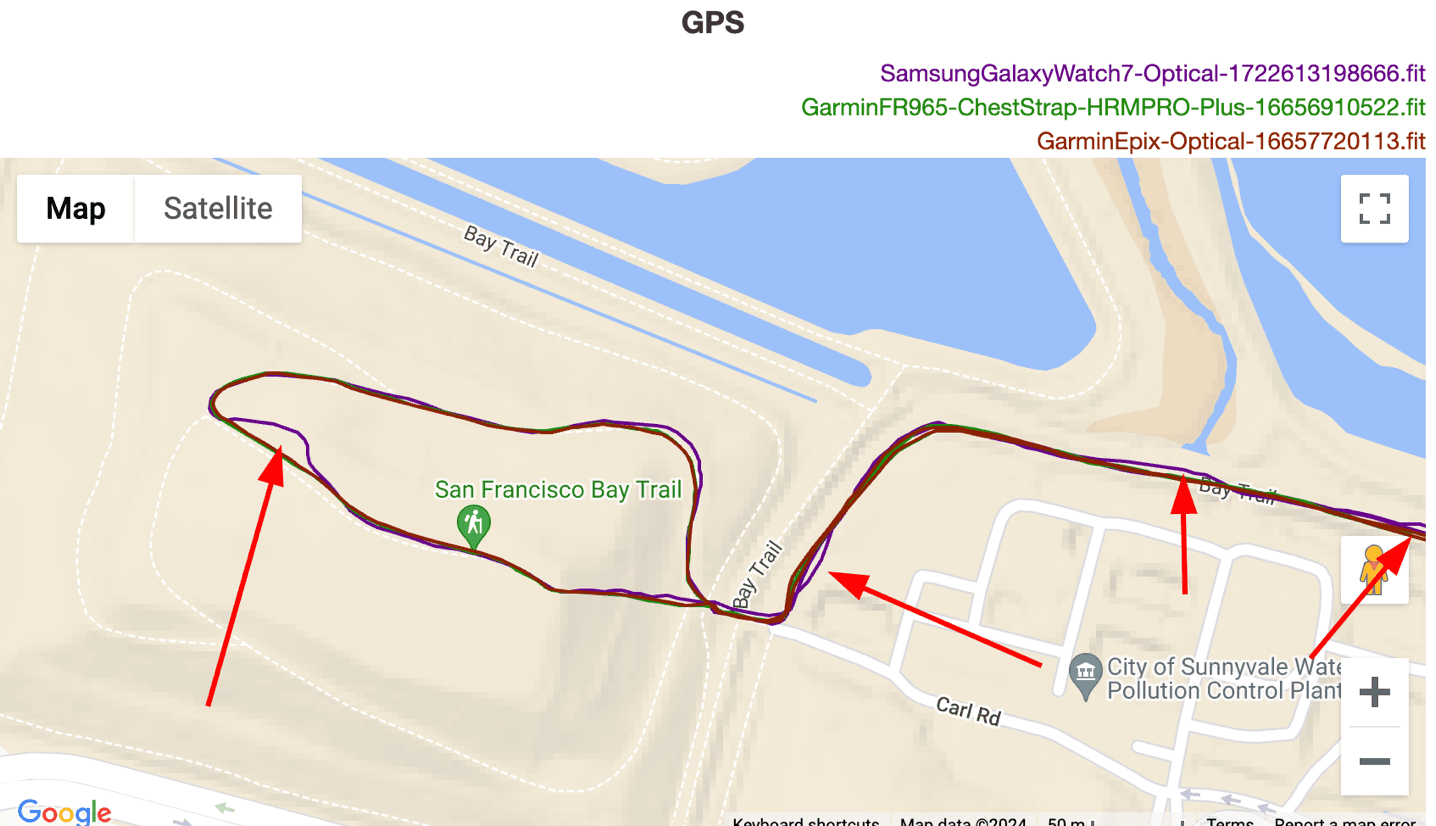
Thus, it’s literally a dumpster fire. Like, the hill I’m is on actually constantly burning gas from dumpster trash gas, and the Watch7 has the GPS accuracy to match.
And again, this carries through to the most recent firmware update as well. Here’s a wide open path, straight as an arrow, and the Watch7 maintains its drunk-uncle status:
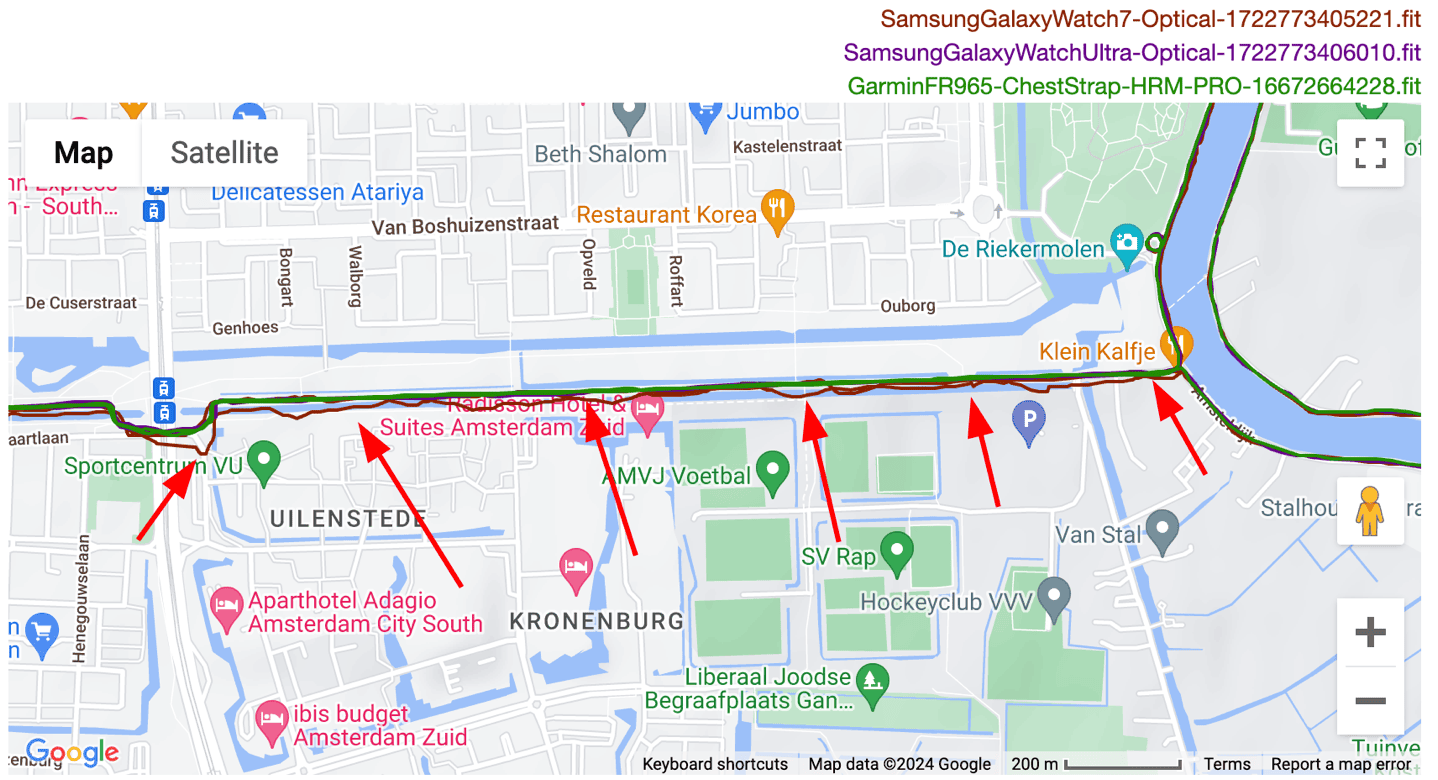
Finally, we’ve got an openwater swim. It’s hard to illustrate how bad this is, because the Samsung Watch7 simply didn’t plot the first 1/3rd of the swim (despite saying it had GPS lock), it just connected two dots together when I stopped to take a photo. As you can see from the rest of it, it’s pretty rough.
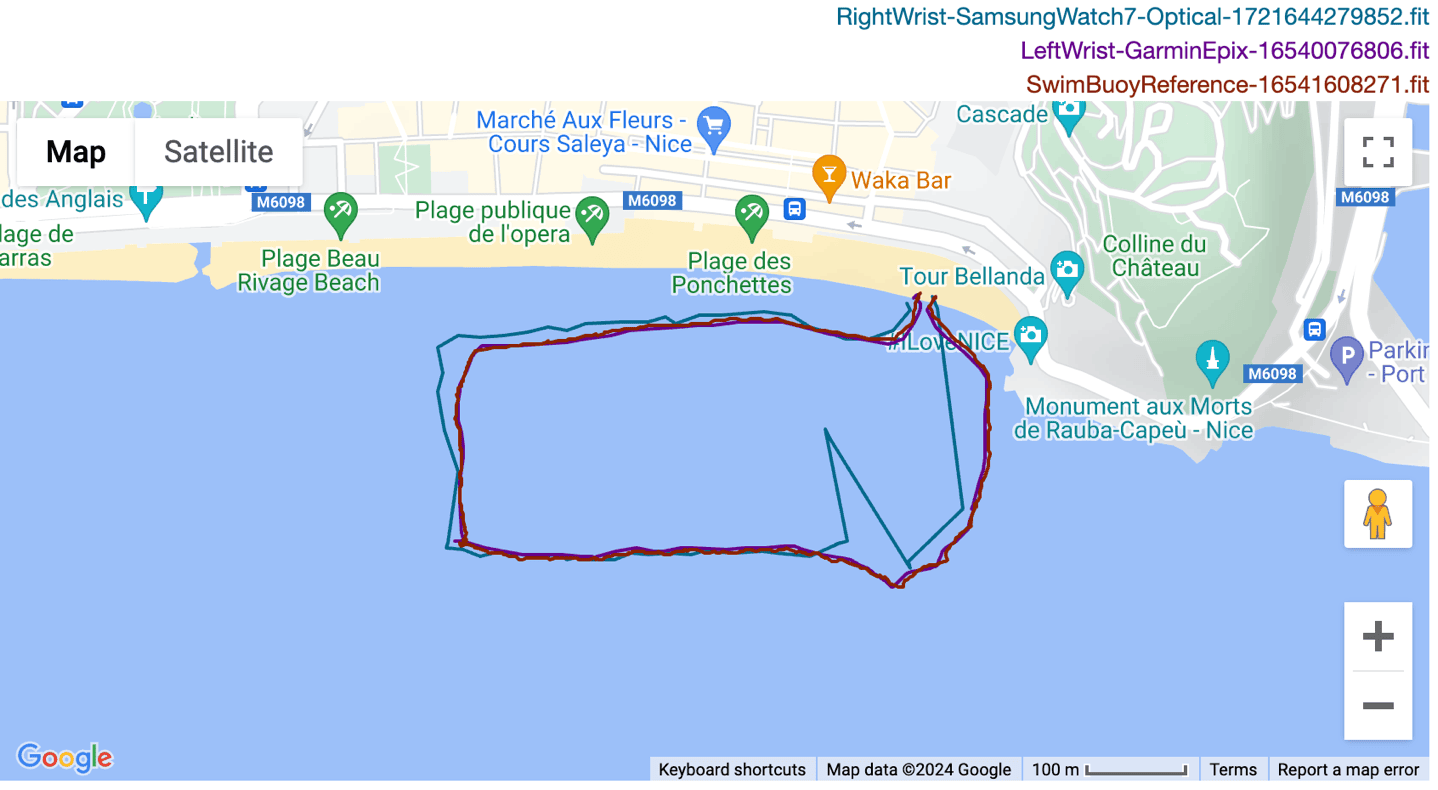
Meanwhile, the Ultra, during its test the day prior, did flawlessly.
Obviously, I can’t be certain why the Watch7 is performing so much more poorly than the Watch Ultra. However, this pattern mirrors what other reviewers have found as well. The accuracy simply isn’t good, and this is across multiple continents, and three weeks of testing on plenty of activities.
While one might look at these variations from the track and see them as minor, they add up over time. Roughly speaking, they add up to 20-30m per kilometer in my testing (sometimes more, but never less). Thus, after a 10KM run, you’re looking at it showing 200-300m longer than you actually ran. This makes you think you’re running faster than you actually are, which can be challenging for both training and racing alike.
Ultimately, while Samsung improved heart rate accuracy notably over the previous Watch6, that accuracy improvement seems tainted when it comes to GPS accuracy on the Watch7. Given Samsung’s history in terms of fixing GPS issues (as well as my history in knowing how challenging it can be to overcome GPS accuracy issues, especially if antenna-related), I’d say there is a low likelihood Samsung will be able to fix the GPS accuracy issues on the Watch7.
Note: All of the charts in these accuracy sections were created using the DCR Analyzer tool. It allows you to compare power meters/trainers, heart rate, cadence, speed/pace, GPS tracks, and plenty more. You can use it as well for your own gadget comparisons, more details here.)
Final Summary:
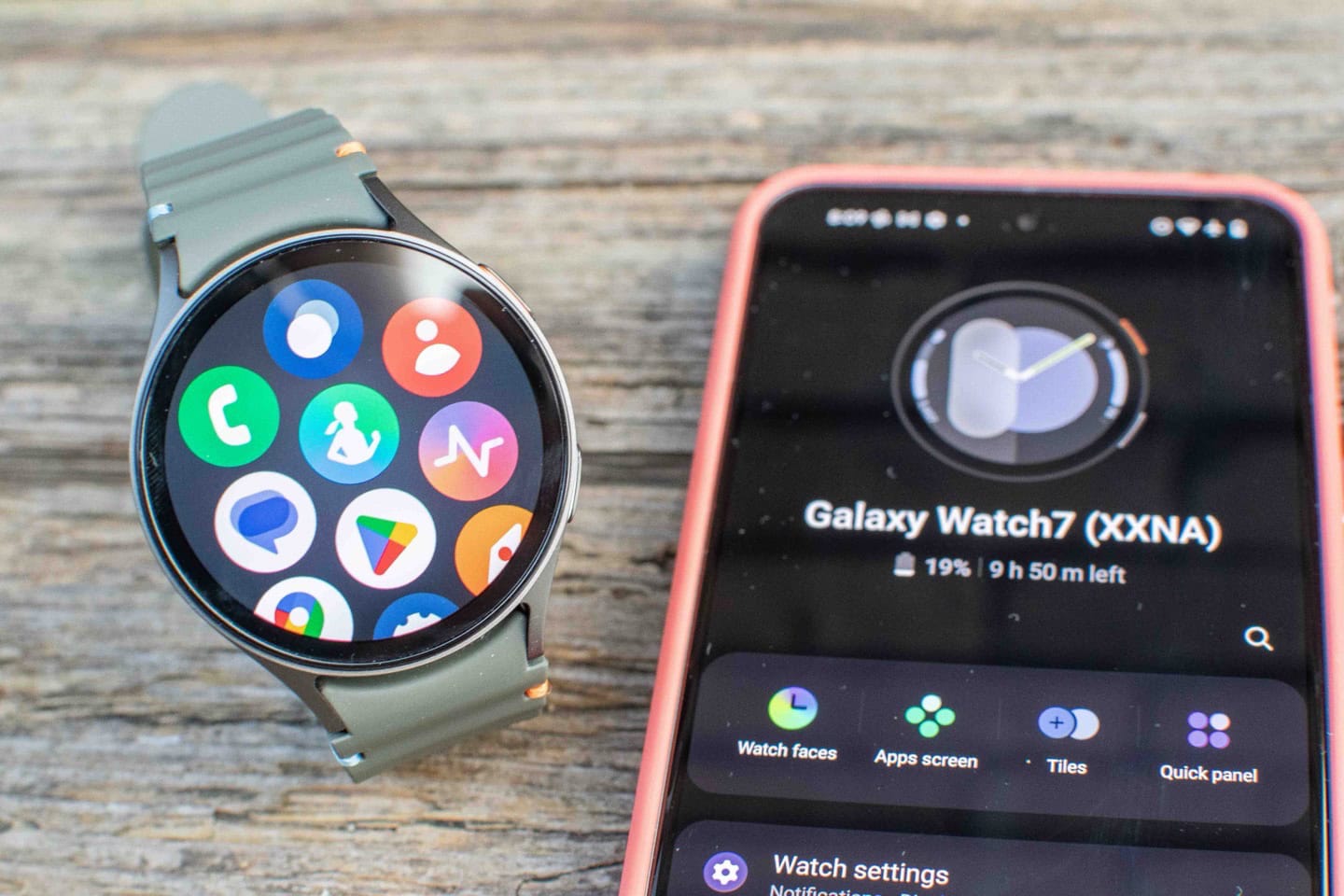
In many ways, the price you pay for the Samsung Galaxy Watch7 will probably dictate how happy you are with the product. Given that Samsung and their retailers often bundle it with phones for effectively free, or nearly as low with a trade-in, it’s a pretty solid watch at that price point.
Further, how much you intend to use it for sports and fitness will also be a major factor. For many people, the heart rate accuracy will be more than accurate enough. Sure, it struggles while cycling, as well as wobbles a bit during steady-state workouts, but for running intervals, it does surprisingly well most of the time. The issue is really more the GPS accuracy, which isn’t good. It wobbles constantly as if it were drunk, rarely able to follow a straight line – even in the easiest of wide-open treeless GPS scenarios.
Beyond that though, from a WearOS standpoint, it’s largely like most other WearOS watches, except now with WearOS 5, and the battery gains that come from it. For the majority of my testing, it was easily achieving 1.5 to upwards of 2 days of battery life (non-LTE configuration). Every once in a while it’d have a battery meltdown, but those were the exception rather than the rule. And the meltdowns seemed easily stopped by just briefly attaching a charger.
Ultimately, it’s good to see Samsung make progress on the two major fitness sticking points of past Samsung watches, even if the GPS here is still wonky (since it’s still a heck of a lot better than last year). And again, if nothing else, the watch is usually quite inexpensive.
With that – thanks for reading!
Found This Post Useful? Support The Site!
Hopefully you found this review/post useful. At the end of the day, I’m an athlete just like you looking for the most detail possible on a new purchase – so my review is written from the standpoint of how I used the device. The reviews generally take a lot of hours to put together, so it’s a fair bit of work (and labor of love). As you probably noticed by looking below, I also take time to answer all the questions posted in the comments – and there’s quite a bit of detail in there as well.
If you're shopping for the Samsung Galaxy Watch 7 or any other accessory items, please consider using the affiliate links below! As an Amazon Associate I earn from qualifying purchases. It doesn’t cost you anything extra, but your purchases help support this website a lot.
Here's a few other variants or sibling products that are worth considering:
And of course – you can always sign-up to be a DCR Supporter! That gets you an ad-free DCR, access to the DCR Quarantine Corner video series packed with behind the scenes tidbits...and it also makes you awesome. And being awesome is what it’s all about!
Thanks for reading! And as always, feel free to post comments or questions in the comments section below, I’ll be happy to try and answer them as quickly as possible. And lastly, if you felt this review was useful – I always appreciate feedback in the comments below. Thanks!


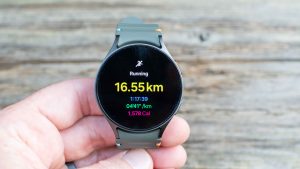
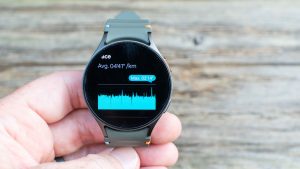
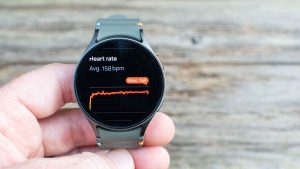
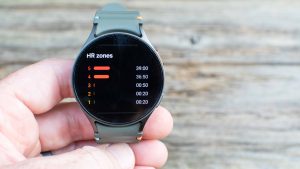
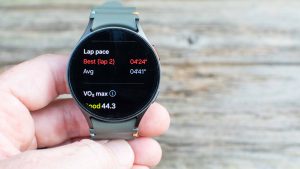
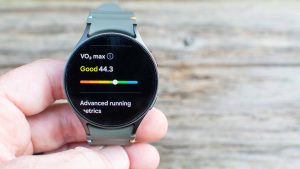
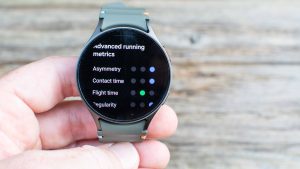
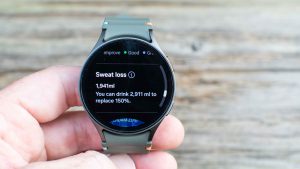
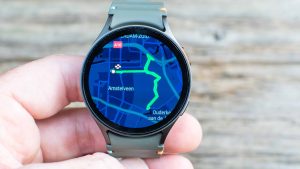
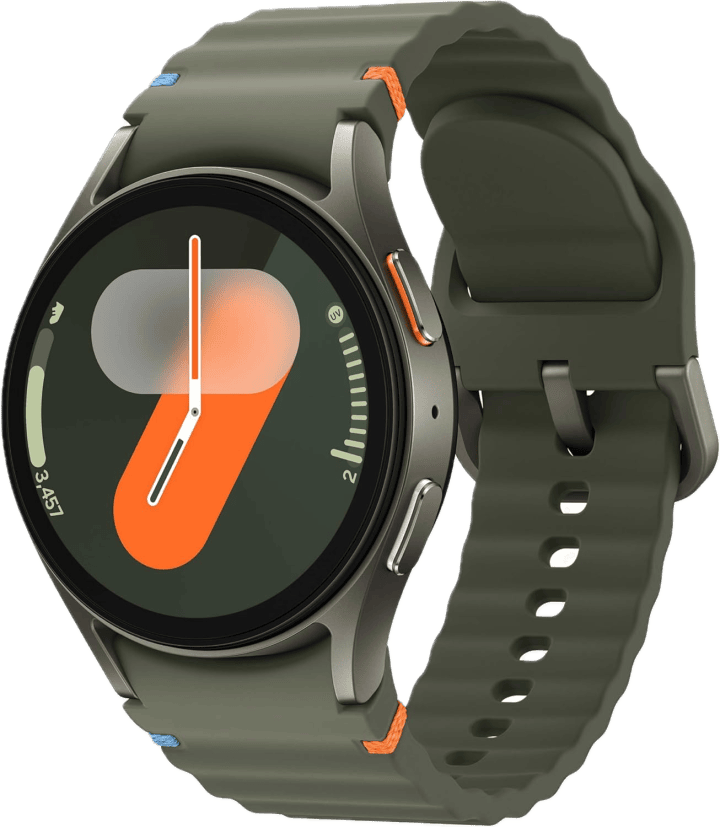
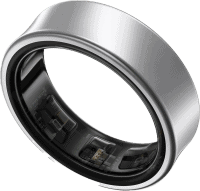
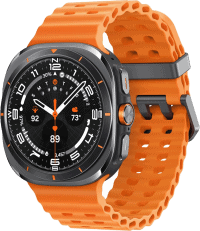





















Wow, massively disappointing. This review (specifically, GPS accuracy) is the only thing I was waiting for to go get a 7. Or not. How could they hit a HR with the Ultra and strike out so badly with the 7?
I’m not an athlete just an old lady been wearing a firbit for years but I need a watch with the fall protection so I don’t have to subscribe to an alert button. Also will.need a few of the other features and the larger screen becsude of bad eyes.. Do you think either one of these would be good. I have a new Samsung phone
.thanks Nd hope I hear back from you
Hi, Joy. If you’re not an athlete, then GPS accuracy will be “good enough”, in your case. Fall protection is good but with this watch, you will also have the ability to press the home key five times in a row and have it auto-dial emergency services for you. The smaller of the 7 still has a surprisingly big screen and it might fit your wrist better than the 45mm version. I would go to your phone provider and check out how they feel and look on you.
Good luck!
I just don’t understand it. There’s a giant company called Samsung that makes all sorts of things: displays, RAM, smartphones, televisions, and so on.
And they can’t manage to produce a smartwatch that offers decent GPS.
They were probably too busy with the new ring in the wearables department;)
I wonder if strava sync is still wonky with Samsung Health. On my Galaxy 4 Watch and S24+ I need too connect with strava almost every day. Which is total bs.
Unfortunately, I have the same experience with GW7 accuracy. Otherwise it is a good watch. So I use it as a smartwatch and keep my FR 955 for sports.
44 or 40?
“Given that Samsung and their retailers often bundle it with phones for effectively free, it’s a pretty solid watch at that price point.”
Pretty solid watch for free. Can anything worse be said about a smartwatch? Or any product? Yikes.
GPS accuracy: presumably these deficiencies can be mitigated by using the phone’s GPS instead? I assume that is easy/possible. With the Fitbit Charge 6, using the phone GPS is really the only realistic option.
Even if possible the phone’s GPS may not better. My S24 has terrible GPS compared to my Garmin watch.
Thank you so much for the info!
It’s amazing how clueless and redundant all “smart watch” reviews are. The only thing anyone ever describes is how it can monitor your heart and tell you how many steps you’ve walked. Whoopee! No discussion of messaging capabilities, phone capabilities, etc – the items that make a smart watch smart. I couldn’t care less about knowing how many steps I’ve walked. A smart watch must be able to read emails, IMs and make calls for it to be a true smart watch. But, this “professional review” mentions none of this.
Hey, genius! In case you didn’t notice, every single one of this site’s reviews are FOCUSED ON THE ATHLETE and the performance of the watch in that regard. There are hundreds of other sites you can go to to get reviews on all the other smart-watch stuff. Maybe those sites would be better suited for you. The people who are here are here for one reason: we are athletes and we want to know how this device does IN THAT REGARD. If we want to know how the watch performs in other areas, we’ll go elsewhere.
What a “professional” reader you are that you don’t even know which website you’re on. Goofy.
Nice write up. Great detail. Thank you.
No power meter support is a deal breaker for me and millions of other cyclists / runners.. Even though Samsung is a member of the Bluetooth Consortium . Samsung still refuses to add power meter Bluetooth connection let alone ant+ capability??
Samsung .. please add running cycling power meter Bluetooth connections!!
I hope they’ll eventually get it right. Their actual watch design is quite good and with Garmin going all stupid with Amoled I have no reason to stick with them anymore. As soon as Samsung gets in the same accuracy ballpark I’m jumping ship.. if it ever happens.
I do not understand this comment, since Samsung is obviously also AMOLED.
Thanks!
Thanks for rhe review. Very complete. Made things very clear.
Thanks. This was quite extensive…
One question, does the GW7 allow music storage/streaming or do I have to bring my phone on my runs.
Hi,
This is a great review and thank you for the effort. When my previous watch and phone died a few years back I excitedly purchased a Galaxy Watch4. Lots of rollout problems I did not expect – Tracking cycling, BMI sensor issues and a host of other issues. Within the first year I sent it out to be repaired two or three times.
At the 1 year + 1 week time the watch stopped recording GPS for all cycling trips. To make matters worse, it started counting STEPS!
Lots of back-and-forth with Samsung, even through their Contact The Office of the CEO to ask for my device to be repaired, which it was once more, and finally to be replaced.
Useless waste of time and effort. I resolved not to purchase a Samsung watch again … But a national retailer I have a lot of points with has them on a slight sale. Thanks for this info and I will keep accumulating until I have enough for a nice Garmin.
Many thanks for this interesting review! What would you recommend between this Samsung Watch 7 and the Garmin Venu 3/3S for someone mostly interested in health (sleep and heart rate) monitoring and some basic statistics on my running (hence some use of the GPS), but not so much in the (still nice-to-have) “smart” features?
Does the ECG capability of the Samsung really bring something more than the simple HR and HRV offered by the Garmin?
Thank you for any advice!